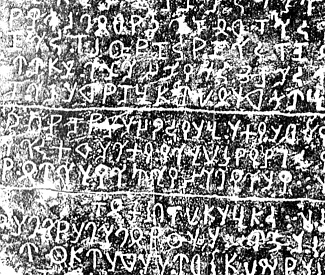

Zitierweise / cite as:
Payer, Alois <1944 - >: Quellenkunde zur indischen Geschichte bis 1858. -- 3. Inschriften. -- 1. Zum Beispiel: Aśoka-Inschriften. -- Fassung vom 2008-04-05. -- http://www.payer.de/quellenkunde/quellen031.htm
Erstmals publiziert: 2008-03-03
Überarbeitungen: 2008-04-05 [Ergänzung]
Anlass: Lehrveranstaltung FS 2008
©opyright: Dieser Text steht der Allgemeinheit zur Verfügung. Eine Verwertung in Publikationen, die über übliche Zitate hinausgeht, bedarf der ausdrücklichen Genehmigung des Verfassers
Dieser Text ist Teil der Abteilung Sanskrit von Tüpfli's Global Village Library
Falls Sie die diakritischen Zeichen nicht dargestellt bekommen, installieren Sie eine Schrift mit Diakritika wie z.B. Tahoma.
Da zur Zeit nicht die Muße habe, meine eigene Übersetzung der Aśoka-Inschriften für eine Internet-Veröffentlichung zu überarbeiten, gebe ich im Folgenden die Übersetzung von Eugen Hultzsch (1857 - 1927) wieder aus seiner vorbildlichen Ausgabe der bis dahin (1925) aufgefundenen Aśoka-Inschriften:
Inscriptions of Aśoka / new ed. By E. Hultzsch. With 55 plates. -- 1925. -- cxxxi, 260 S. : Ill. ; 35 cm. -- Supersedes: Inscriptions of Aśoka / Prepared by Alexander Cunningham. -- Calcutta, 1887. -- (Corpus inscriptionum indicarum ; vol. I)
Obwohl die Übersetzung von Hultzsch in Einzelheiten überholt und korrigiert ist, ist sie im Ganzen immer noch eine Meisterleistung. Für die Fußnoten, Faksimiles und Transliteration der Texte konsultiere man das Originalwerk von Hultzsch.
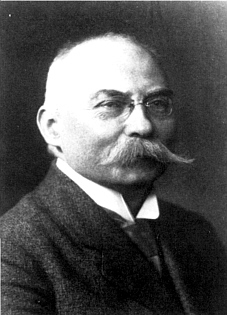 |
|
Eugen Hultzsch (1857 - 1927) |
|
"Hultzsch, Eugen, Indologe, geb. 29.3.1857
Dresden, gest. 16.1.1927 Halle/Saale Hultzsch studierte in Bonn und Leipzig Indologie, klassische Philologie, Persisch und Arabisch, wurde 1879 promoviert und setzte die indologischen Studien in London und Wien fort, wo er sich 1882 für orientalische Sprachen habilitierte. Er beschäftigte sich vor allem mit der indischen Epigraphik, ferner mit indischen Sanskrit-Manuskripten und brachte von der 1884 nach Kaschmir unternommenen Reise seltene Manuskripte mit. Hultzsch wirkte seit 1886 als Epigraphist to the Governement of Madras, Examiner of Sanskrit und Fellow of the University of Madras und wurde 1903 o. Prof. in Halle/Saale. Er beherrschte das klassische Sanskrit und Prakrit, veröffentlichte u.a. Inscriptions of Aśoka (1925) und war Herausgeber der South-Indian Inscriptions (Bd. 1-3, 1890-1903)." [Quelle: Deutsche biographische Enzyklopädie & Deutscher biographischer Index. -- CD-ROM-Ed. -- München : Saur, 2001. -- 1 CD-ROM. -- ISBN 3-598-40360-7. -- s.v.] |
Im Ganzen sind immer noch die Ausführungen von Eugen Hultzsch gültig:
"CHAPTER II. THE AUTHOR OF THE INSCRIPTIONS The king at whose orders the rock- and pillar-edicts published in the first and second parts of this volume were engraved, gives his name or title in various Prākṛt forms of which the Sanskrit would be Devānāṃpriyaḥ Priyadarśī rājā? This full
form of his title is shortened into Devānāṃpriyaḥ in section C of the Dhauli and Jaugaḍa rock-edict X, in all texts of the rock-edicts XII and XIII after the opening section, in which the full style is preserved, and in the Delhi-Toprā pillar-edict VII, RR. In the two separate rock-edicts at Dhauli and Jaugaḍa, in the Queen's pillar-edict, and in the Kauśāmbī pillar-edict, Devānāṃpriyaḥ alone is found.Among the records published in the third and fourth parts of this volume, the Rummindeī and Nigālī Sāgar pillars exhibit the full form Devānāṃpriyaḥ Priyadarśī raja. The Maski rock-inscription opens with the genitive case of Devānāṃpriya Aśoka. On the Sārnāth pillar and in the Rūpnāth, Sahasrām, Bairāṭ, and the three Mysore rock-inscriptions we have only Devānāṃpriyaḥ. On the Sāṃchī pillar this word is lost; but the contents of the Sāṃchī and Sārnāth pillars are so nearly related to those of the Kauśāmbī edict on the Allahabad-Kosam pillar, that they can be safely referred to the same royal author. The same applies to the rock-inscriptions at Rūpnāth, &c, which remind us of the rock- and pillar-edicts in many significant details.
There remain the Calcutta-Bairāṭ rock-inscription and the three Barābar Hill cave-inscriptions. In the former the king styles himself Priyadarśī rājā, and in the three others rājā Priyadarśī. In the Calcutta-Bairāṭ record the king shows a strong interest in Buddhism. It would be, therefore, hypercritical not to assign this document to the same sovereign who paid visits to Sambodhi, (rock-edict VIII, C), to Luṃmini (Rummindeī pillar), and to the Stūpa of Konākamana (Nigālī Sāgar pillar). We cannot, however, decide with certainty whether the three Barābar Hill inscriptions belong to the same king or to another member of his dynasty. In favour of the former alternative it may perhaps be urged that two of the caves on the Barābar Hill were dedicated to the Ājīvikas when the donor had been 'anointed twelve years'. For, this happens to be the regnal year in which the author of the rock- and pillar-edict commenced to issue 'rescripts on morality'; see the pillar-edict VI, B, and cf. the rock-edict IV, K.
The etymological meaning of the term Devānāṃpriya is 'dear to the gods'. According to Patañjali's Mahābhāshya on Pāṇini, II, 4, 56, and V, 3, 14, this word was used as an honorific like bhavan, dirghayuh, and ayushman. Pāṇini himself does not mention Devānāṃpriya, but states that the termination of the genitive case is preserved at the end of the first member of compounds if the meaning is abusive ṣaṣṭhyā ākrośe, VI, 3, 21). The Kāśikā commentary adduces the two examples caurasyakulaṃ ' the family of a thief, and vṛṣalasyakulaṃ, 'the family of a low-caste man'. Kātyāyana affixes to Pāṇini's Sutra five Vārttikas, the third of which states that the compound Devānāṃpriya ought to be added. Neither the Mahābhāshya nor the Kāśikā have the word murkhe, 'with the meaning of "fool", which the Siddhāntakaumudī adds to the Vārttika. This secondary meaning of Devānāṃpriya was already known to Patañjali's commentator Kaiyaṭa, while Kātyāyana and Patañjali ignore it, although Patañjali on Pāṇini, II, 4, 56, seems to have used Devānāṃpriya in an ironical sense. In Baṇa's Harshacharita it is found twice as an honorific. In the same way Devāṇuppiya is employed frequently in Jaina literature.In the Dīpavaṃsa, Devanampiya is prefixed to the name of Aśoka's contemporary, Tissa of Ceylon, and is often used alone to denote him, and in the Nāgārjunī Hill cave-inscriptions it follows the name of Aśoka's grandson Daśaratha. In a few of the inscriptions published in this volume it is employed as a synonym of rājan, ' a king': In the Kālsī, Shāhbāzgaṛhī, and Mānsehrā texts of the rock-edict VIII, A, the king's predecessors are called Devānaṃpiya and Devānāṃpriya, while the Gīrnār and Dhauli versions have rājāno and lājāne; and the word Devānaṃpiye in the second separate edict at Dhauli (twice in section G and thrice in I) corresponds to lājā in the Jaugaḍa text of the same edict (sections H and J).
As stated above (p. xxviii), another epithet of the king to whom the inscriptions published in this volume are due was Priyadarśin, 'he who glances amiably'. Both Piyadassi and Piyadassana, ' of amiable appearance', occur repeatedly in the Dīpavaṃsa as equivalents of Aśoka, the name of the great Maurya king. In the drama Mudrārākskasa, Piadaṃsaṇa is prefixed to Chandasiri, i.e. Chandragupta, the name of Aśoka's grandfather.
Before discussing Prinsep's identification of the king Devānāṃpriya Priyadarśin of the inscriptions with the Maurya king Aśoka, it will be advisable to quote from the texts a few details which are of leading importance in this connexion. The opening section of the Calcutta-Bairāṭ rock-inscription informs us that Priyadarśin was a Māgadha king, i. e. a ruler of Māgadha. From the rock-edict V, M, we learn that his capital was Pāṭaliputra; for, the words 'both in Pāṭaliputra and in the outlying [towns]' at Gīrnār correspond to 'here and in all the outlying towns' at Kālsī, Shāhbāzgaṛhī, Mānsehrā, and Dhauli. In the second and thirteenth rock-edicts the king refers to a number of contemporary Yona, i.e. Greek, kings : the rock-edict II, A, mentions 'the Yona king Antiyoka (Antiyaka at Gīrnār, Antiyoga at Kālsī and Mānsehrā) and the kings who are the neighbours of this Antiyoka'; and the rock-edict XIII, Q, 'the Yona king Antiyoka (Antiyoga at Kālsī and Mānsehrā), and beyond him four kings, viz. Turamāya (Tulamaya at Kālsī), Antekina (Antikini at Shāhbāzgaṛhī), Makā (Magā at Gīrnār), and Alikasudara (Alikyashudala at Kālsī)'.
The great decipherer of the old Brāhmī alphabet, James Prinsep, at first ascribed the edicts to Devānaṃpiya Tissa of Ceylon. This is of course impossible because we know now that the author of the edicts calls himself a king of Māgadha, and that he resided at Pāṭaliputra. The discovery of the Nāgārjunī Hill cave-inscriptions of Dashalatha Devānaṃpiya, whom Prinsep at once identified with Daśaratha, the grandson of the Maurya king Aśoka (id., p. 676 ft), and the fact that Turnour had found Piyadassi or Piyadassana used as a surname of Aśoka in the Dīpavaṃsa, induced Prinsep to abandon his original view, and to identify king Devānāṃpriya Priyadarśin with Aśoka himself (id., p. 790 ff.). A limine another member of the Maurya dynasty
might be meant as well; for, as stated above (p. xxx), the eighth rock-edict shows that the king's predecessors also bore the title Devānāṃpriya, and the Mudrārākshasa applies the epithet Priyadarśana to Chandragupta. Every such doubt is now set at rest by the discovery of the Maski edict, in which the king calls himself Devānāṃpriya Aśoka.In February, 1838, Prinsep published the text and a translation of the second rock-edict He found in the Gīrnār version of it (l. 3) the words Aṃtiyako Yona-rājā, and in the Dhauli version (l. 1) Aṃtiyoke nāma Yona-lājā, and identified the Yona king Antiyaka or Antiyoka with Antiochus III of Syria. In March, 1838, he discovered in the Gīrnār edict XIII (l. 8) the names of Turamāya, Aṃtikona, and Magā, whom he most ingeniously identified with Ptolemy II Philadelphus of Egypt, Antigonus Gonatas of Macedonia (?), and Magas of Cyrene. At the same time he modified his earlier theory, and now referred the name Antiyoka to Antiochus I or II of Syria, preferably the former (id., p. 224 ff.).
On the Gīrnār rock the name of a fifth king, who was mentioned after Magā, is lost. The Shāhbāzgaṛhī version calls him Alikasudara. Norris recognised that this name corresponds to the Greek Αλεξανδρος, and suggested hesitatingly that Alexander of Epirus, the son of Pyrrhus, might be meant by it. This identification was endorsed by Westergaard, Lassen, and Senart. But Professor Beloch now thinks that Alexander of Corinth, the son of Craterus, has a better claim.
As will appear in the sequel, the mention of these five contemporaries in the inscriptions of king Devānāṃpriya Priyadarśin confirms in a general way the correctness of Prinsep's identification of the latter with Aśoka, the grandson of Chandragupta whose approximate time we know from Greek and Roman records. Antiochus I Soter of Syria reigned 280-261 B.C., his son Antiochus II Theos 261-246, Ptolemy II Philadelphus of Egypt 285-247, Antigonus Gonatas of Macedonia 276-239, Magas of Cyrene c. 300-c. 250, Alexander of Epirus 272-c. 255, and Alexander of Corinth 252-c. 244. The rock-edict XIII cannot be placed earlier than twelve years after Aśoka's abhisheka, when he commenced publishing 'rescripts on morality'. If we assume that the rock-edicts are arranged in chronological order, it cannot have been issued earlier than thirteen years after the abhisheka, when Aśoka appointed 'Mahāmātras of morality' as he tells us in edict V. If the Alikasudara of edict XIII is Alexander of Epirus, its date would fall between 272 and 255, and if Alexander of Corinth is meant, between 252 and 250. For fixing the period of Aśoka's reign within narrower limits, we are thrown back on what information can be gathered from Indian and classical literature concerning Aśoka's grandfather Chandragupta.
The historical tradition of India, Ceylon, and Burma is unanimous in naming as the founder of the Maurya dynasty Chandragupta, and as his two immediate successors Bindusāra and Aśoka. The pseudo-prophetic account of the Purāṇas runs thus :
'Kauṭilya (or Chāṇakya) will establish king Chandragupta in the kingdom. Chandragupta will be king twenty-four years, Bindusāra twenty-five years, and Aśoka thirty-six years.'
According to the Dīpavaṃsa, Chandragupta reigned twenty-four years (V, 73, 100), and Bindusāra's son Aśoka thirty-seven years (V, 101).
The Mahāvamsa states that the Brāhmaṇa Chanakya anointed the Maurya Chandragupta (V, 16 f.), and that Chandragupta reigned twenty-four years, his son Bindusāra twenty-eight years (V, 18), and Bindusāra's son Aśoka (V, 19) thirty-seven years (XX, 6).
Buddhaghosha's Samāntapāsādikā agrees with the Mahāvaṃsa in allotting twenty-four years to Chandragupta and twenty-eight'years to Bindusāra.
The Burmese tradition assigns twenty-four years to Chandragupta and twenty-seven years to Bindusāra.
It will be seen that all sources agree in fixing the length of Chandragupta's reign at twenty-four years. To Bindusāra the Ceylonese chronicles allot twenty-eight years, Bigandet twenty-seven years, and the Purāṇas twenty-five years.
The Ceylonese sources state that Aśoka succeeded his father Bindusāra 214 years after Buddha's Nirvāṇa, and that his anointment took place four years after his father's death, or 218 years after the Nirvāṇa. The Burmese tradition confirms the two dates 214 and 218.
As, according to the Ceylonese sources, Bindusāra ruled twenty-eight years and Chandragupta twenty-four years, the former would have reigned A.B. 186—214, and the latter A.B. 162-186. If we deduct the year of Chandragupta's accession to the throne (162) from the traditional date of the Nirvāṇa, 544 B.C., the result is 382 B.C. This Would be about sixty years earlier than the actual accession of Chandragupta as ascertained from Greek sources. For, luckily, the approximate time of king Chandragupta of Pāṭaliputra has been already settled by one of the great pioneers of Indian research, Sir William Jones, who identified him with Σανδρακοττος of Παλιβοθρα, the contemporary of Seleucus Nikator.
Various devices were proposed in order to account for this chronological error, until Fleet showed that the Buddha-varsha of 544 B.C. is a comparatively modern fabrication, of the twelfth century, and that the difference of about sixty years is the quite natural result of accumulated mistakes which were made in rounding off the figures of the regnal years of the kings of Ceylon.
While thus the alleged date of the Nirvāṇa in 544 B.C. and that of Chandragupta's accession in 382 B.C. have no practical value, the traditional interval of 218 years between the Nirvāṇa and Aśoka's abhisheka might still be considered authentic. There are, however, two facts which in my opinion render it somewhat suspicious. It includes a period of 100 years between the Nirvāṇa and the Second Council. Such, a nice round sum as just 100 years looks very much like a clumsy guess and a pure invention. Secondly, the traditional figures of the Northern Buddhists are almost totally at variance with those of the Southern Buddhists.The leading passage concerning Chandragupta's date is found in Justin's Epitoma Pompei Trogi, XV, 4:
'[Seleucus] multa in Oriente post divisionem inter socios regni Macedonici bella gessit. Principio Babyloniam cepit; inde auctis ex victoria viribus Bactrianos expug-navit. Transitum deinde in Indiam fecit, quae post mortem Alexandri, veluti a cervicibus iugo servitutis excusso, praefectos eius occiderat. Auctor libertatis Sandrocottus fuerat, sed titulum libertatis post victoriam in servitutem verterat; siquidem occupato regno populum, que ab externa dominatione vindicaverat, ipse servitio premebat. Fuit hic humili quidem genere natus, sed ad regni potestatem maiestate numinis inpulsus. Quippe cum procacitate sua Nandrum regem offendisset, interfici a rege iussus salutem pedum celeritate quaesierat. Ex qua fatigatione cum somno captus iaceret, leo ingentis formae ad dormientem accessit sudoremque profluentem lingua ei detersit expergefactumque blande reliquit. Hoc prodigio primum ad spem regni inpulsus contractis latronibus Indos ad novitatem regni sollicitavit. Molienti deinde bellum adversus praefectos Alexandri elephantus ferus infinitae magnitudinis ultro se obtulit et veluti domita mansuetudine eum tergo excepit duxque belli et proeliator insignis fuit. Sic adquisito regno Sandrocottus ea tempestate, qua Seleucus futurae magnitudinis fundamenta iaciebat, Indiam possidebat, cum quo facta pactione Seleucus conpositisque in Oriente rebus in bellum Antigoni descendit.'
McCrindle translates this as follows:
'[Seleucus] waged many wars in the East after the partition of Alexander's empire among his generals. He first took Babylonia, and then with his forces augmented by victory subjugated the Bactrians. He then passed over into India, which after Alexander's death, as if the yoke of servitude had been shaken off from its neck, had put his prefects to death. Sandrocottus had been the leader who achieved their freedom, but after his victory he had forfeited by his tyranny all title to the name of liberator; for, having ascended the throne, he oppressed with servitude the very people whom he had emancipated from foreign thraldom. He was born in humble life, but was prompted to aspire to royalty by an omen significant of an august destiny. For when by his insolent behaviour he had offended king Nandrus, and was ordered by that king to be put to death, he had sought safety by a speedy flight. When he lay down overcome with fatigue and had fallen into a deep sleep, a lion of enormous size approaching the slumberer licked with its tongue the sweat which oozed profusely from his body, and when he awoke quietly took its departure. It was this prodigy which first inspired him with the hope of winning the throne, and so, having collected a band of robbers, he instigated the Indians to overthrow the existing government. When he was thereafter preparing to attack Alexanders prefects, a wild elephant of monstrous size approached him, and kneeling submissively like a tame elephant received him on to its back and fought vigorously in front of the army. Sandrocottus having thus won the throne was reigning over India when Seleucus was laying the foundations of his future greatness. Seleucus, having made a treaty with him and otherwise settled his affairs in the East, returned home to prosecute the war with Antigonus.'
The same transactions are referred to in Appian's Ρωμαικα, book Συριακη, chapter 55:
' [Seleucus] crossed the Indus and waged war on Androcottus, king of the Indians who dwelt about it, until he made friends and entered into relations of marriage with him.'
According to Strabo, Seleucus ceded to Sandrocottus a tract of land to the west of the Indus, entering into a matrimonial alliance with him and receiving in exchange five hundred elephants. We know from various sources that Megasthenes became the ambassador of Seleucus at Chandragupta's court. Strabo adds that Deimachus was sent on an embassy to Chandragupta's son, whom he calls Amitrochades :
' Megasthenes and Deïmachus were sent on an embassy, the former to Sandrocottus at Palimbothra, the other to Amitrochades his son; and they left accounts of their sojourn in the country'.
It may be concluded from this interesting notice that Chandragupta's son and successor Bindusāra had the surname Amitraghāta, i. e. ' the slayer of enemies'. The same king is referred to as a contemporary of Antiochus (I Soter of Syria) in a curious anecdote preserved by Athenaeus:
' Dried figs were so eagerly desired by all men.....that even Amitrochates, the king of the Indians, wrote to Antiochus asking him, says Hegesander, to purchase and send him sweet wine, dried figs, and a sophist: and that Antiochus wrote back: " We shall send you dried figs and sweet wine; but it is not lawful in Greece to sell a sophist."'
If this statement of Athenaeus is combined with the preceding one of Strabo, it appears that the friendly intercourse which had existed between Seleucus and Chandragupta, was continued by their respective sons and successors, Antiochus I and Bindusāra-Amitraghāta, and that Megasthenes, the ambassador of Seleucus at the court of Chandragupta, was succeeded by Deïmachus, the ambassador of Antiochus I at the court of Bindusāra-Amitraghāta. From Pliny we learn that another Greek potentate, Ptolemy II Philadelphus of Egypt (B.C. 285-247), sent Dionysius as ambassador to an unnamed Indian king, who may be supposed to have been either Bindusāra or Aśoka.
I now return to the question of Chandragupta's date. Seleucus I Nikator of Syria (B.C. 312-280) 'arrived in Cappadocia in the autumn of 302 [the year preceding the battle of Ipsus]. The march thither from India must have required at least two summers. Consequently, the peace with Chandragupta has to be placed about the summer of 304, or at the latest in the next winter.' Thus the coronation of Chandragupta falls between B.C. 323 (Alexander's death) and 304 (the treaty with Seleucus). As the consolidation of an empire which, as described by Megasthenes in his Ινδικα, reached from Paṭnā to the Indus, must have been a matter of many years, I feel inclined to shift the date of Chandragupta's accession towards the earlier limit and to adopt as a working date the year B.C. 320 which Fleet has proposed. With this starting-point, and if the length of reigns as given in the Mahāvaṃsa is accepted, Chandragupta would have ruled 320-296, and Bindusāra 296-268. Aśoka would have been crowned (four years after his father's death) in B.C. 264. This date is confirmed approximately by Aśoka's thirteenth rock-edict, which, as stated above (p. xxxi), cannot be placed earlier than twelve or thirteen years after his abhisheka. 264—12/13 = 252/251 would be one or two years before the last possible year (B.C. 250) in which all the Greek kings mentioned in that edict were still alive. This synchronism would prove that the date of Chandragupta's coronation, on which that of Aśoka's coronation depends, can hardly be placed later than B.C. 320. It would follow further that the Antiyoka of edict XIII (and probably also of rock-edict II) was not Antiochus I, but Antiochus II (261-246), and that the Alikasudara of edict XIII was not Alexander of Epirus, but Alexander of Corinth (252-c. 244). But we must remember that the above figures rest only on the Ceylonese tradition, while the Purāṇas assign to Bindusāra twenty-five instead of twenty-eight years, and that, accordingly, Chandragupta's coronation might fall about three years later than B.C. 320. Besides, it must be kept in mind that the upper limit of Chandragupta's coronation is the death of Alexander the Great in B.C 323. The working date of B.C. 320 has the advantage of being the mean of the two outside dates 323 and 317.
I now append a list of the regnal dates which are incidentally mentioned in Aśoka's inscriptions, adding in brackets the year B.C. to which each year of his reign may be supposed to correspond.
- Eight years after the coronation (B.C. 256). The king conquered (the country of) the Kaliṅgas ; rock-edict XIII.
- Ten years after the coronation (B.C. 254). He went (on a visit) to Sambodhi (i.e. Bodh-Gayā); rock-edict VIII.
- Twelve years after the coronation (B.C. 252) :
- He ordered his officers to set out on a complete tour (throughout their charges) every five years ; rock-edict III.
- He promoted morality by public shows of edifying subjects ; rock-edict IV.
- He published rescripts on morality ; pillar-edict VI.
- He gave two caves to the Ājīvikas ; two of the Barābar Hill cave-inscriptions.
- Thirteen years after the coronation (B.C. 251). He appointed superintendents of morality; rock-edict V.
- Fourteen years after the coronation (B.C. 250). He enlarged the Stūpa of Konākamana to the double (of its size); Nigālī Sāgar pillar.
- Nineteen years after the coronation (B.C 245). He gave a cave (to the Ājīvikas); the third Barābar Hill cave-inscription.
- Twenty years after the coronation (B.C. 244). He visited the Buddha's birthplace at Luṃmini and the Stūpa of Konākamana ; Rummindeī and Nigālī Sāgar pillars.
- Twenty-six years after the coronation (B.C. 238). He issued the pillar-edicts I, IV, V, VI.
- Twenty-seven years after the coronation (B.C. 237). He issued the Delhi-Toprā pillar-edict VII."
[Quelle: Inscriptions of Aśoka / new ed. By E. Hultzsch. With 55 plates. -- 1925. -- cxxxi, 260 S. : Ill. ; 35 cm. -- Supersedes: Inscriptions of Aśoka / Prepared by Alexander Cunningham. -- Calcutta, 1887. -- (Corpus inscriptionum indicarum ; vol. I). -- S. XXVIII - XXXVI. -- Dort in den Fußnoten die Belege.]
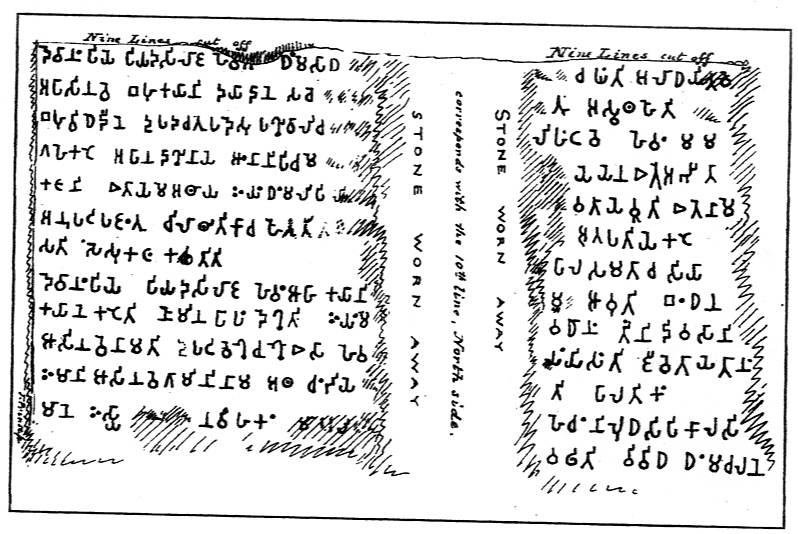
Abb.: Brāhmī-Schrift: Abschrift der Inschrift auf der Säule von Meerut (मेरठ, میرٹھ)
[Bildquelle: JASB 6 (1837), pl. 42. -- Hier nach Falk, 2006, S. 183]
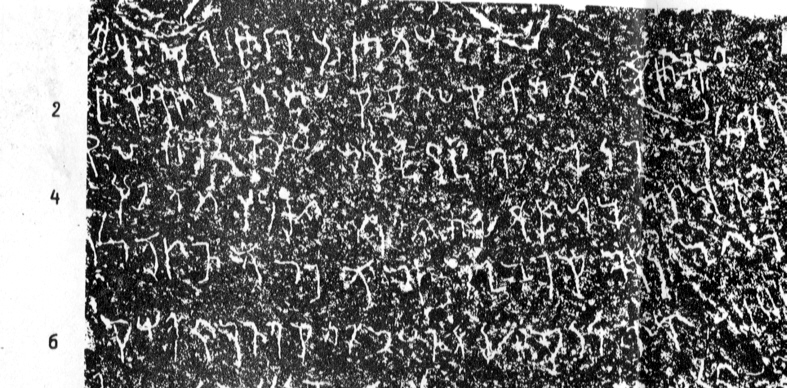
Abb.: Khāroṣṭhī-Schrift: Ausschnitt aus den Felsenedikten
in Shāhbāzgarhī
[Quelle der Abb.: Inscriptions of Aśoka / new ed. By E. Hultzsch. With 55 plates. -- 1925. -- cxxxi, 260 S. : Ill. ; 35 cm. -- Supersedes: Inscriptions of Aśoka / Prepared by Alexander Cunningham. -- Calcutta, 1887. -- (Corpus inscriptionum indicarum ; vol. I). -- Vor S. 57.]
Einen ersten Eindruck von den regionalen Sprachvarianten gibt die synoptische Übersicht der Versionen des ersten Felsenedikts:
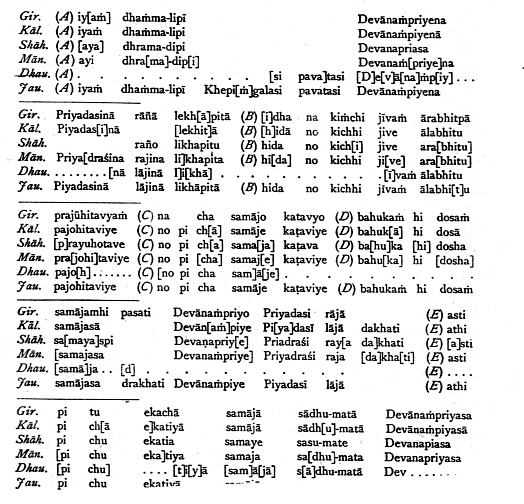
Abb.: Synopsis der Versionen des ersten Felsenedikts
[Quelle der Abb.: Inscriptions of Aśoka / new ed. By E. Hultzsch. With 55 plates. -- 1925. -- cxxxi, 260 S. : Ill. ; 35 cm. -- Supersedes: Inscriptions of Aśoka / Prepared by Alexander Cunningham. -- Calcutta, 1887. -- (Corpus inscriptionum indicarum ; vol. I). -- S. 183.]
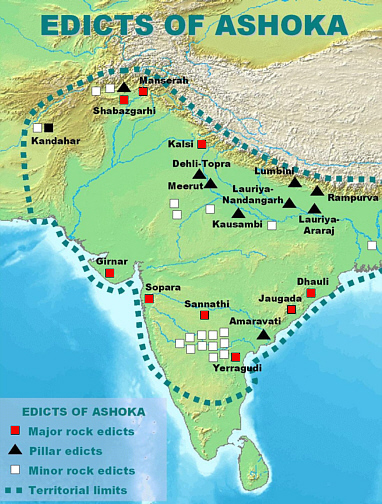
Abb.: Ungefähre Lage der Standorte der Felsenedikte
[Bildquelle: Wikipedia, GNU FDLicense]
Die Felsenedikte befinden sich in:
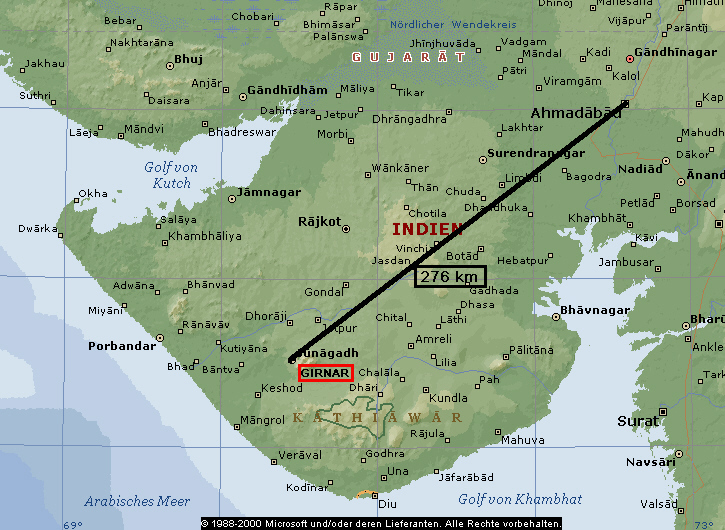
Abb.: Lage des Gīrnār-Berges (ગીરનાર) bei
Jūnāgāḍh (જૂનાગઢ), Gujarat
[©MS-Encarta]
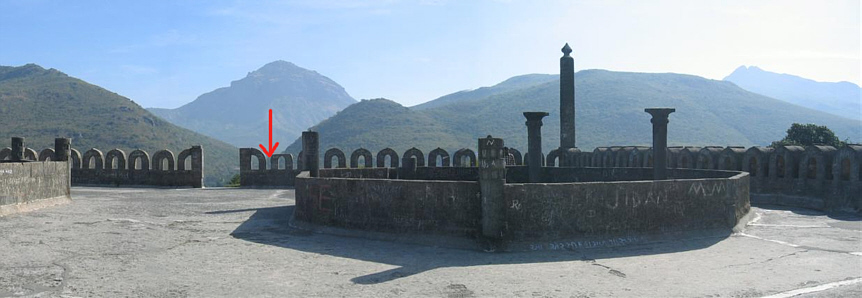
Abb.: Blick auf den Gīrnār-Berg (im Hintergrund), die Felsenedikte sind ungefähr
dort, wohin der Pfeil weist
[Bildquelle: Jouni Lehti. --
http://www.flickr.com/photos/jlehti/2207220930/. --
![]()
![]()
![]() Creative
Commons Lizenz (Namensnennung, keine kommerzielle Nutzung)]
Creative
Commons Lizenz (Namensnennung, keine kommerzielle Nutzung)]
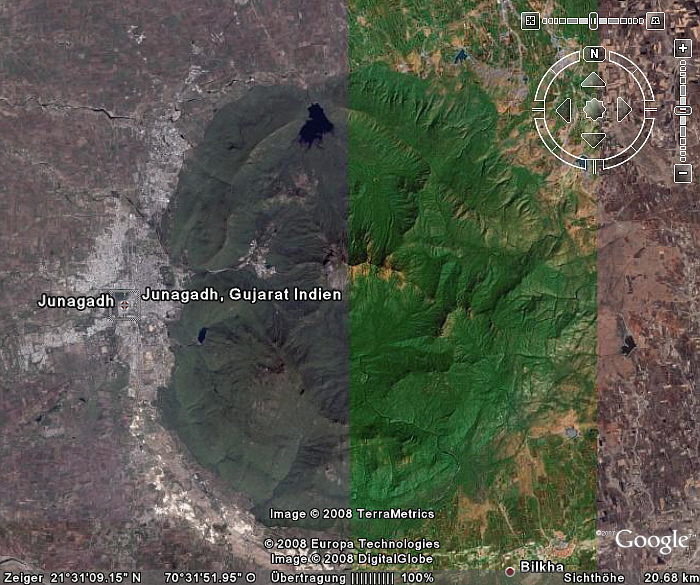
Abb.: Gīrnār-Berge
[Bildquelle: ©Google Earth. -- Zugriff am 2008-02-29]
"Gīrnār [ગીરનાર] (also known as "Gīrnār Hill") is a collection of mountains in the Junagadh [જૂનાગઢ] District of Gujarat, India. The tallest of these rises to 945 meters (3600 feet), the highest peak in Gujarat. The five peaks of Gīrnār are topped by 866 intricately carved stone temples. A sturdy stone path — a pilgrimage route for both Hindus and Jains — climbs from peak to peak. It is claimed that there are exactly 9,999 steps from the trailhead to the last temple on the highest peak, but the actual number is roughly 8,000. Every year, a race is held, running from the base of the mountain to the peak and back. The locals in nearby Junagadh insist that the fastest-ever time was 42.36 minutes. However, most people take 5-8 hours to climb the mountain.
In the Hindu religion, the legend is that climbing Gīrnār barefooted earns one a place in Heaven. There is one holy stone; it is said that if a person attempts suicide from that stone then he becomes a part of Heaven.
The nearby Gir Forest serves as sanctuary for the last remaining Asiatic Lions.
It is also famous for the Kathiawadi culture in the adjacent region."
[Quelle: http://en.wikipedia.org/wiki/Gīrnār. -- Zugriff am 2008-02-28]
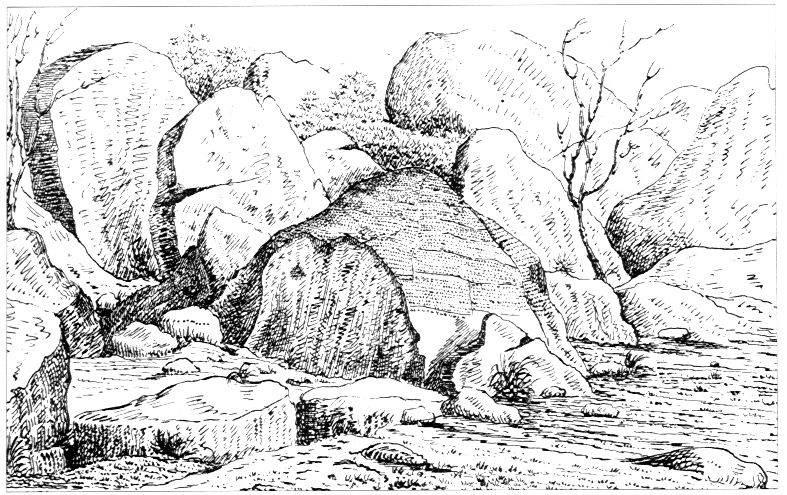
Abb.: Der Fels mit den Inschriften in Gīrnār, wie ihn Postans 1838 sah
[(JASB 7.1838, Pl. XII); hier nach Falk, 2006, S. 119]
Hultzsch schreibt über die Felsenedikte in Gīrnār:
"FIRST PART: THE ROCK-EDICTS The above term is meant to comprise
- the existing versions of the well-known 'fourteen edicts', and
- the two 'separate edicts' which the Dhauli and Jaugaḍa versions substitute for edicts XI to XIII.
It does not include the minor rock-inscriptions, which will be treated in the fourth part.
1. The Gīrnār Rock (Text, p. 1).
This famous set of Aśoka's fourteen edicts is found about a mile to the east of Junāgaṛh, the capital of the Junāgaṛh State in the Kāṭhiāvāṛ Peninsula, 'and at the entry of the dell or gorge which leads into the valley that girdles the mighty and sacred Gīrnār' mountain. The inscription 'covers considerably over a hundred square feet of the uneven surface of a huge rounded and somewhat conical granite boulder, rising 12 feet above the surface of the ground, and about 75 feet in circumference at the base.' The boulder bears, beside Aśoka's edicts, two other valuable documents: An inscription of the Mahākshatrapa Rudradaman records the restoration of the lake Sudarśana, which had been 'originally constructed by the Vaiśya Pushyagupta, the provincial governor (rāshṭriya) of the Maurya king Chandragupta, and subsequently adorned with conduits by the Yavana king Tushāspha for Aśoka the Maurya.' Among local names it mentions Girinagara, i. e. the town of Junāgaṛh or its ancient representative, and Ūrjayat, i. e. the mountain now called Gīrnār. The third inscription on the boulder is dated in the reign of the Gupta king Skandagupta and records further repairs of the lake Sudarśana made in a. d. 456-7 by Chakrapālita, the son of Parṇadatta who was governor of Surāshṭra.
The Aśoka inscription occupies the north-east face of the boulder. The fourteen edicts are arranged in two columns and divided from one another by straight lines. As may be seen on the third of the plates issued with Wilson's article in JRAS, 12. 153 ff., the left column consists of edicts I to V and the right one of edicts VI to XII ; and edicts XIII and XIV are placed below V and XII. When Major James Tod visited Gīrnār in December 1822, the inscription seems to have been intact. Subsequently portions of edicts V and XIII were blasted with gunpowder by the workmen of a pious merchant who constructed a causeway from Junāgaṛh to Gīrnār. At the recommendation of the late Dr. Burgess a shed has been specially built to protect the boulder from the sun and rain.
The first decipherment of the Brāhmī alphabet and, with it, of the Gīrnār inscription, is due to the learning and ingenuity of James Prinsep. His transcript and translation were based on tracings on cloth which had been taken in 1835 by Captain Lang for the Rev. Dr. J. Wilson of Bombay. Fresh copies were made by Lieutenant Postans and Captain Lang in 1838, and by Captain (afterwards General) Le Grand Jacob and Professor Westergaard in 1842. These materials were utilized by Mr. E. Norris for drawing up an improved plate of the Gīrnār inscription, from which Professor H. H. Wilson's transcript and translation in JRAS, vol. 12 (1850), were made. No better materials were available to three other scholars who examined the Gīrnār version, viz. Professor Chr. Lassen (Indische Altertumskunde), E. Burnouf (Lotus de la Bonne Loi ; Paris, 1852), and Professor H. Kern (Over de Jaartelling der Zuidelijke Buddhisten en de Gedenkstukken van Acoka den Buddhist; Amsterdam, 1873).
The first perfectly mechanical estampages of the Gīrnār edicts were prepared in 1875 by Dr. J. Burgess. These were reproduced by collotype in 1876 in ASWI, 2. 98 ff., and also in IA, 5. 257 ff, with an English translation of Kern's Dutch versions of part of the edicts.
A complete edition of the Gīrnār edicts is included in Senart's Inscriptions de Piyadasi, vol. I. An abridged English translation of his work appeared in IA, vols. 9 and 10. In JA (8), 12. 311 ff., Senart added the results of his inspection of the Gīrnār rock in situ. Bühler published a number of corrections and the text of edict XIII in his Beiträge zur Erklärung der Aśoka-Inschriften (ZDMG, vols. 37-48), and the full text of the Gīrnār version in EI, 2. 447 ff. The plates which accompany this article are much clearer than those issued in 1876, but seem to have been touched up by hand. A Collection of Prakrit and Sanskrit Inscriptions printed at Bhavnagar (without year) contains the text, Sanskrit and English translations, and facsimiles, of the Gīrnār edicts.
Two fragments of the lost portion of edict XIII were recovered recently and are now preserved in the Junāgaṛh Museum. Both of them were discussed by Senart (JRAS, 1900. 335 ff), and the second of them also by Bühler (VOJ, 8. 318 ff). Both pieces are shown in the plate which accompanies my transcript of edict XIII.
As regards the Brāhmī alphabet of the Gīrnār inscription I can refer the reader to Bühler's Indian Paleography, edited by Fleet (IA, vol. 33, Appendix), § 16. The chief peculiarity of the Gīrnār alphabet is the addition of the horizontal bar, marking the length of initial ā, at the top of a, while it is elsewhere attached to the middle of the letter. The formation of groups of consonants, and the peculiar way in which the letter r is expressed in combination with other consonants, will be discussed in the chapter on the Gīrnār dialect (below, p. lviii. f.)."
[Quelle: Inscriptions of Aśoka / new ed. By E. Hultzsch. With 55 plates. -- 1925. -- cxxxi, 260 S. : Ill. ; 35 cm. -- Supersedes: Inscriptions of Aśoka / Prepared by Alexander Cunningham. -- Calcutta, 1887. -- (Corpus inscriptionum indicarum ; vol. I). -- S. IXf.]
(A) This rescript on morality has been caused to be
written by king Devānāṃpriya Priyadarśin.
(B) Here no living being must be killed and sacrificed.
(C) And no festival meeting must be held.
(D) For king Devānāṃpriya Priyadarśin sees much evil in festival meetings.
(E) But there are also some festival meetings which are considered meritorious
by king Devānāṃpriya Priyadarśin.
(P) Formerly in the kitchen of king Devānāṃpriya Priyadarśin many hundred
thousands of animals were killed daily for the sake of curry.
(G) But now, when this rescript on morality is written, only three animals are
being killed (daily) for the sake of curry, (viz.) two peacocks (and) one deer,
(but) even this deer not regularly.
(H) Even these three animals shall not be killed in future.
(A) Everywhere in the dominions of king
Devānāṃpriya Priyadarśin, and likewise among (his) borderers, such as the Choḍas, the Pāṇdyas,
the Satiyaputa, the Ketalaputa, even Tāmraparṇī, the Yona king Antiyaka, and
also the
kings who are the neighbours of this Antiyaka,—everywhere two (kinds of) medical
treatment were established by king Devānāṃpriya Priyadarśin, (viz.) medical
treatment for men and medical treatment for cattle.
(B) And wherever there were no herbs that are beneficial to men and beneficial
to cattle, everywhere they were caused to be imported and to be planted.
(C) Wherever there were no roots and fruits, everywhere they were caused to be
imported and to be planted.
(D) On the roads wells were caused to be dug, and trees were caused to be
planted for the use of cattle and men.
(A) King Devānāṃpriya Priyadarśin speaks thus.
(B) (When I had been) anointed twelve years, the following was ordered by me.
(C) Everywhere in my dominions the Yuktas, the Rājūka, and the Prādeśika shall
set out on a complete tour (throughout their charges) every five years for this
very purpose, (viz.) for the following instruction in morality as well as for
other business.
(D) 'Meritorious is obedience to mother and father. Liberality to friends,
acquaintances, and relatives, to Brāhmaṇas and Śramaṇas is meritorious.
Abstention from killing animals is meritorious. Moderation in expenditure (and)
moderation in possessions are meritorious.'
(E) The council (of Mahāmātras) also shall order the Yuktas to register (these
rules) both with (the addition of) reasons and according to the letter.
(A) In times past, for many hundreds
of years, there had ever been promoted the killing of animals and the hurting of
living beings, discourtesy to relatives, (and) discourtesy to Brāhmaṇas and
Śramaṇas.
(B) But now, in consequence of the practice of morality on the part of king
Devānāṃpriya Priyadarśin, the sound of drums has become the sound of morality,
showing the people representations of aerial chariots, representations of
elephants, masses of fire, and other divine figures.
(C) Such as they had not existed before for many hundreds of years, thus there
are now promoted, through the instruction in morality on the part of king
Devānāṃpriya
Priyadarśin, abstention from killing animals, abstention from hurting living
beings, courtesy to relatives, courtesy to Brāhmaṇas and Śramaṇas, obedience to
mother (and) father, (and) obedience to the aged.
(D) In this and many other ways is the practice of morality promoted.
(E) And king Devānāṃpriya Priyadarśin will ever promote this practice of
morality.
(P) And the sons, grandsons, and great-grandsons of king Devānāṃpriya
Priyadarśin will promote this practice of morality until the aeon of destruction
(of the world), (and) will instruct (people) in morality, abiding by morality
(and) by good conduct.
(G) For this is the best work, viz. instruction in morality.
(H) And the practice of morality is not (possible) for (a person) devoid of good
conduct
(I) Therefore promotion and not neglect of this object is meritorious.
(J) For the following purpose has this been caused to be written, (viz. in order
that) they should devote themselves to the promotion of this practice, and that
the neglect (of it) should not be approved (by them).
(K) This was caused to be written by king Devānāṃpriya Priyadarśin (when he had
been) anointed twelve years.
(A) King Devānāṃpriya Priyadarśin
speaks thus.
(B) It is difficult to perform virtuous deeds.
(C) He who starts performing virtuous deeds accomplishes something difficult.
(D) Now, by me many virtuous deeds have been performed.
(E) Therefore (among) my sons and grandsons, and (among) my descendants (who
shall come) after them until the aeon of destruction (of the world), those who
will conform to this (duty) will perform good deeds.
(F) But he who will neglect even a portion of this (duty) will perform evil
deeds.
(G) For sin is easily committed.
(H) In times past (officers) called Mahāmātras of morality (Dharma-mahāmātra)
did not exist before.
(I) But Mahāmātras of morality were appointed by me (when I had been) anointed
thirteen years.
(J) These are occupied with all sects in establishing morality..........of those
who are devoted to morality (even) among the Yoṇas, Kambojas, and Gandhāras, the
Risṭikas and Peteṇikas, and whatever other western borderers (of mine there are).
(K) They are occupied with servants and masters ..........for the..........happiness of those who are devoted to morality, (and) in freeing (them) from
desire (for worldly life).
(L) They are occupied in supporting prisoners (with money).......... (if one
has) children, or with those who are bewitched (i.e. incurably ill ?), or with
the aged.
(M) They are occupied everywhere, both in Pāṭaliputra and in the outlying
..........and whatever other relatives of mine (there are).
(N) These Mahāmātras of morality..........whether one is eager for
morality..........
(O) For the following purpose has this rescript on morality been written..........
(A) King Devānāṃpriya Priyadarśin
speaks thus.
(B) In times past neither the disposal of affairs nor the submission of reports
at any time did exist before.
(C) But I have made the following (arrangement).
(D) Reporters are posted everywhere, (with instructions) to report to me the
affairs of the people at any time, while I am eating; in the harem, in the inner
apartment, even at the cowpen, in the palanquin, and in the parks.
(E) And everywhere I am disposing of the affairs of the people.
(F) And if in the council (of Mahāmātras) a dispute arises, or an amendment is
moved, in connexion with any donation or proclamation which I myself am ordering
verbally, or (in connexion with) an emergent matter which has been delegated to
the Mahāmātras, it must be reported to me immediately, anywhere, (and) at any
time.
(G) Thus I have ordered.
(H) For I am never content in exerting myself and in dispatching business.
(I) For I consider it my duty (to promote) the welfare of all men.
(J) But the root of that (is) this, (viz.) exertion and the dispatch of business.
(K) For no duty is more important than (promoting) the welfare of all men.
(L) And whatever effort I am making, (is made) in order that I may; discharge
the debt (which I owe) to living beings, (that) I may make them happy in this (world),
and (that) they may attain heaven in the other (world).
(M) For the following purpose has this rescript on morality been caused to be
written, (viz.) that it may last long, and that my sons, grandsons, and
great-grandsons may conform to this for the welfare of all men.
(N) But it is difficult to accomplish this without great zeal.
(A) King Devānāṃpriya Priyadarśin
desires (that) all sects may reside everywhere.
(B) (For) all these desire both self-control and purity of mind.
(C) But men possess various desires (and) various passions.
(D) Either they will fulfil the whole, or they will fulfil (only) a portion (of
their duties).
(E) But even one who (practises) great liberality, (but) does not possess
self-control, purity of mind, gratitude, and firm devotion, is very mean.
(A) In times past kings used to set
out on pleasure-tours.
(B) On these (tours) hunting and other such pleasures were (enjoyed).
(C) But when king Devānāṃpriya Priyadarśin had been anointed ten years, he went
to Saṃbodhi.
(D) Therefore these tours of morality (were undertaken).
(E) On these (tours) the following takes place, (viz.) visiting Brāhmaṇas and
Śramaṇas and making gifts (to them), visiting the aged and supporting (them)
with gold, visiting the people of the country, instructing (them) in morality,
and questioning (them) about morality, as suitable for this (occasion).
(F) This second period (of the reign) of king Devānāṃpriya Priyadarśin becomes a
pleasure in a higher degree.
(A) King Devānāṃpriya Priyadarśin
speaks thus.
(B) Men are practising various ceremonies during illness, or at the marriage of
a son or a daughter, or at the birth of a son, or when setting out on a journey
on these and other (occasions) men are practising various ceremonies.
(C) But in such (cases) women are practising many and various vulgar and useless
ceremonies.
(D) Now, ceremonies should certainly be practised.
(E) But ceremonies like these bear little fruit indeed.
(F) But the following practice bears much fruit, viz. the practice of morality.
(G) Herein the following (are comprised), (viz.) proper courtesy to slaves and
servants, reverence to elders, gentleness to animals, (and) liberality to
Brāhmaṇas and Śramaṇas ; these and other such (virtues) are called the practice
of morality.
(H) Therefore a father, or a son, or a brother, or a master ought to say:— 'This
is meritorious. This practice should be observed until the (desired) object is
attained.'
(I) And it has been said also: 'Gifts are meritorious.'
(J) But there is no such gift or benefit as the gift of morality or the benefit
of morality.
(K) Therefore a friend, or a well-wisher, or a relative, or a companion should
indeed admonish (another) on such and such an occasion:—'This ought to be done;
this is meritorious. By this (practice) it is possible to attain heaven.'
(L) And what is more desirable than this, viz. the attainment of heaven ?
(A) King Devānāṃpriya Priyadarśin does
not think that either glory or fame conveys much advantage, except (on account
of his aim that) in the present time, and in the distant (future), men may (be
induced) by him to practise obedience to morality, and that they may conform to
the duties of morality.
(B) On this (account) king Devānāṃpriya Priyadarśin is desiring glory and fame.
(C) But whatever effort king Devānāṃpriya Priyadarśin is making, all that (is)
for the sake of (merit) in the other (world), (and) in order that all (men) may
run little danger.
(D) But the danger is this, viz. demerit.
(E) But it is indeed difficult either for a lowly person or for a high one to
accomplish this without great zeal (and without) laying aside every (other aim).
(F) But among these (two) it is indeed (more) difficult to accomplish for a high
(person).
(A) King Devānāṃpriya Priyadarśin
speaks thus.
(B) There is no such gift as the gift of morality, or acquaintance through
morality, or the distribution of morality, or kinship through morality.
(C) Herein the following are (comprised), (viz.) proper courtesy to slaves and
servants, obedience to mother (and) father, liberality to friends, acquaintances,
and relatives, to Brāhmaṇas and Śramaṇas, (and) abstention from killing animals.
(D) Concerning this a father, or a son, or a brother, or a friend, an
acquaintance, or a relative, (or) even (mere) neighbours, ought to say: 'This
is meritorious. This ought to be done.'
(E) If one is acting thus, the attainment of (happiness) in this world is (secured),
and endless merit is produced in the other (world) by that gift of morality.
(A) King Devānāṃpriya Priyadarśin is
honouring all sects: both ascetics and householders; both with gifts and with
honours of various kinds he is honouring them.
(B) But Devānāṃpriya does not value either gifts or honours so (highly) as (this),
(viz.) that a promotion of the essentials of all sects should take place.
(C) But a promotion of the essentials (is possible) in many ways.
(D) But its root is this, viz. guarding (one's) speech, (i. e.) that neither
praising one's own sect nor blaming other sects should take place on improper
occasions, or (that) it should be moderate in every case.
(E) But other sects ought to be duly honoured in every case.
(F) If one is acting thus, he is both promoting his own sect and benefiting
other sects.
(G) If one is acting otherwise than thus, he is both hurting his own sect and
wronging other sects, as well.
(H) For whosoever praises his own sect or blames other sects,—all (this) out of
devotion to his own sect, (i. e.) with the view of glorifying his own sect,—if
he is acting thus, he rather injures his own sect very severely.
(I) Therefore concord alone is meritorious, (i. e.) that they should both hear
and obey each other's morals.
(J) For this is the desire of Devānāṃpriya, (viz.) that all sects should be full
of learning, and should be pure in doctrine.
(K) And to those who are attached to their respective (sects)ought to be spoken
to (as follows).
(L) Devānāṃpriya does not value either gifts or honours so (highly) as (this),
(viz.) that a promotion of the essentials of all sects should take place.
(M) And many (officers) are occupied for this purpose, (viz.) the Mahāmātras of
morality, the Mahāmātras controlling women, the inspectors of cowpens, and other
classes (of officials).
(N) And this is the fruit of it, (viz.) that both the promotion of one's own
sect takes place, and the glorification of morality.
(A)......... . the Kaliṅgas..........
(B)..........one hundred thousand in number were those who were slain
there, (and) many times as many those who died.
(C) After that, now that (the country of) the Kaliṅgas has been taken, a zealous
study of morality..........
(D).....[the repentance] of Devānāṃpriya..........
(E)..........slaughter, death, and deportation of people, this is considered
very painful and deplorable by Devānāṃpriya.
(G) . . ........Brāhmaṇas or Śramaṇas, [or] other .......... obedience to
mother (and) to father, obedience to elders..........to friends, acquaintances,
companions, and relatives, [to] slaves..........or deportation of (their)
beloved ones.
(H)..........[companions] and relatives are then incurring misfortune,
this (misfortune) as well becomes an injury to those (persons). (I) This is
shared [by] all ..........
(J)..........these classes..........except among the Yonas..........where men are not indeed attached to some sect.
(K) As many people as at that time..........part is considered deplorable by
Devanam[priya],
(L)..........what can be forgiven.
(M) And even the forests which are (included) in the dominions of Devānāṃpriya
..........
(N) They are [told]..........of Devānāṃpriya..........
(O)..........towards all beings abstention from hurting, self-control,
impartiality, and kindness.
(Q)..........has been won by [Devā]nāṃpriya here and among all..........the Yona king, and beyond him four kings, (viz.) Turamāya, Antekina, Magā..........
(R).....here in the king's territory, [among] the Yonas and Kambo[jas]
..........among the [A]ndhras and Pārindas,—everywhere (people) are conforming
to Devānāṃpriya's instruction in morality.
(S) Even where the envoys..........and the instruction in morality, are
conforming to morality..........
(T)..........this conquest,—a conquest (won) in every respect (and)
repeatedly,—causes the feeling of satisfaction.
(U) This satisfaction has been obtained (by me) at the conquest by morality.
(W)..........[Devānā]ṃpriya.
(X) For the following purpose this [rescript] on morality..........should not
think that a [fresh] conquest ought to be made, (that), if a conquest does
please them, mercy..........
(Y)..........in the other world.
(AA)..........both in this world and in the other world.
Unterhalb des 13. Felsenedikts, rechte Seite:
............. the entirely white elephant bringing indeed happiness to the whole world.
Shāhbāzgarhī, Mardan (مردان) District, North-West Frontier Province (NWFP) (شمال مغربی سرحدی صوبہ), Pakistan
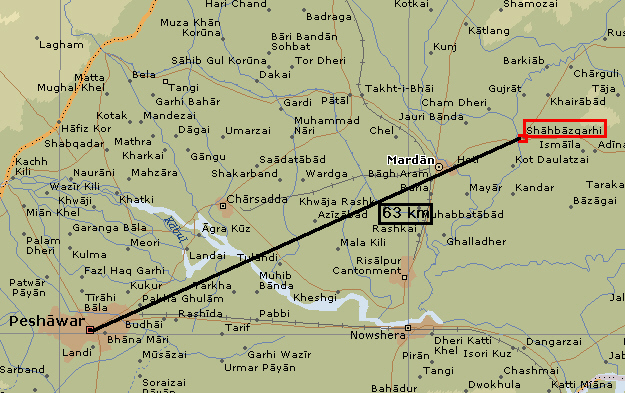
Abb.: Lage von Shāhbāzgarhī
[©MS Encarta]

Abb.: Lage der Felsedikte 1 - 11 (links) und 13 - 14 (rechts)
[nach Cunningham, 1877, Pl. XXIX; hier nach Falk, 2006, S. 133]
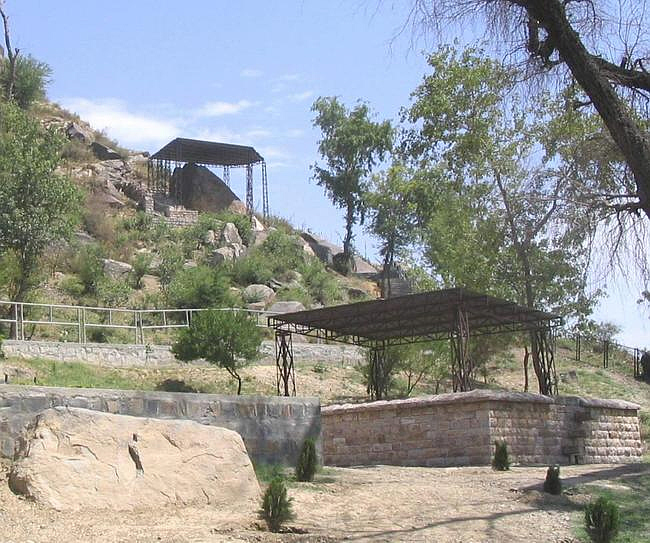
Abb.: Lage der Felsedikte, Shāhbāzgarhī
[Bildquelle: Livius. --
http://www.livius.org/man-md/mauryas/mauryas.html. -- Zugriff am 2008-04-05.
-- "© Jona Lendering. Photos can be downloaded and used for non-commercial
purposes, but you have to acknowledge Livius."]
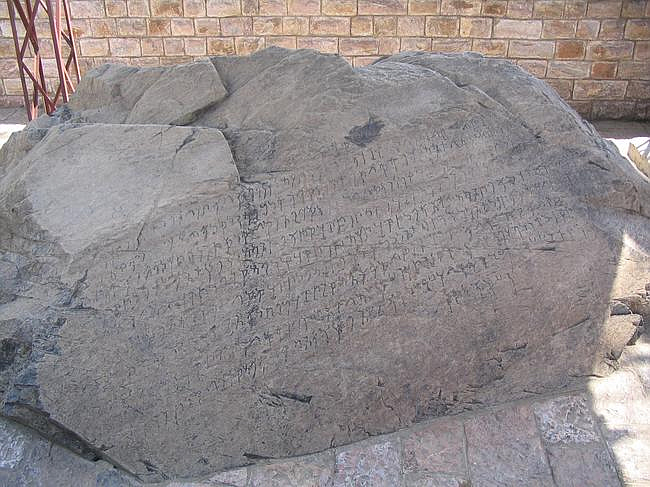
Abb.: Felsedikte, Shāhbāzgarhī
[Bildquelle: Livius. --
http://www.livius.org/a/pakistan/shahbazgarhi/shahbazgarhi.html. -- Zugriff am 2008-04-05.
-- "© Jona Lendering. Photos can be downloaded and used for non-commercial
purposes, but you have to acknowledge Livius."]
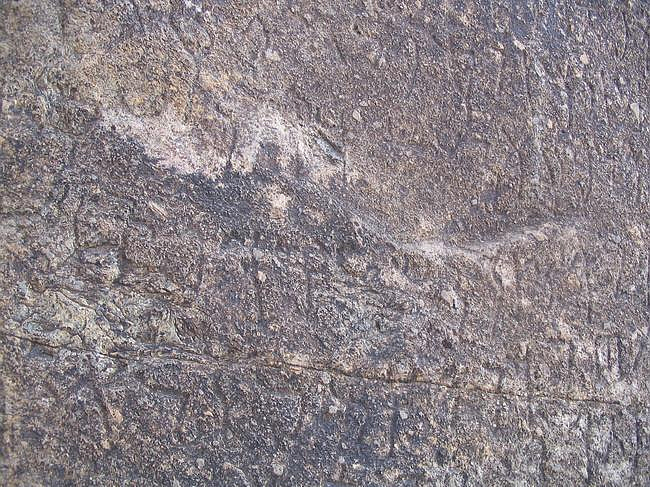
Abb.: Felsedikte, Shāhbāzgarhī
[Bildquelle: Livius. --
http://www.livius.org/a/pakistan/shahbazgarhi/shahbazgarhi.html. -- Zugriff am 2008-04-05.
-- "© Jona Lendering. Photos can be downloaded and used for non-commercial
purposes, but you have to acknowledge Livius."]
Hultzsch schreibt über die Felsenedikte in Shāhbāzgarhī:
"III. The Shāhbāzgaṛhī Rock (Text, p. 50). While the alphabet of the two preceding sets of the fourteen edicts is the Brāhmī, this one is written in those north-western cursive characters running from the right to the left which used to be called Indo-Bactrian or Ariano-Pali, but to which Bühler restored the indigenous name Kharoshṭhī. The honour of the decipherment of this alphabet is divided between Prinsep, Lassen, Norris, and Cunningham. A number of Kharoshṭhī letters had been already identified from bilingual coins of the Indo-Grecian and Indo-Scythian kings, before the Shāhbāzgaṛhī inscription was discovered.
Shāhbāzgaṛhī is a village on the Makām river, nine miles from Mardān, the headquarters of the Yūsufzai subdivision of the Peshāvar district of the North-West Frontier Province. The inscription is about half a mile distant from this village and two miles from the village of Kapurdagaṛhī. It 'is engraved on a large shapeless mass of trap rock, lying about 80 feet up the slope of the hill, with its western face looking downwards towards the village of Shāhbāzgaṛhī.' The edicts I to XI are on the east face (edict VII being entered on the left at the top of the rock), and the edicts XIII and XIV are on the west face. Edict XII is engraved on a separate boulder, which is now enclosed within a wall.
M. (afterwards General) Court, of Mahārāja Ranjit Singh's service, first notified the existence of a Kharoshṭhī inscription near Shāhbāzgaṛhī in 1836 and gave a few letters copied by himself. In 1838 Captain Burnes, being at Peshāvar, sent an agent to Shāhbāzgaṛhī, who returned with an imperfect paper impression. In the same year Mr. C. Masson obtained through a young man a partial impression on calico. He then proceeded to the spot himself and prepared fresh copies. His zeal deserves much praise, as at that time a journey through such an unpacified tract involved considerable personal risk. Masson's materials were brought to Europe and examined by Norris, who first read in them the word Devanaṃpiyasa. With the help of this discovery, Dowson ascertained that the portion of which a facsimile is given in JRAS, 8 (1846). 303, is a duplicate of edict VII of the Gīrnār inscription. Norris further found that the front of the rock contained the edicts I to XI, and traced on the back of it portions of edict XIII. He also published the text of edict VII (id., p. 306 f.). In 1850 Wilson contributed a tentative transcript of both faces of the Shāhbāzgaṛhī rock, accompanied by plates drawn by Norris from Masson's copies (id., 12. 153 ff.). An independent eye-copy of the Shāhbāzgaṛhī inscription was prepared by Cunningham (Inscriptions of Aśoka, p. 10).
Senart's transcript in his Inscriptions de Piyadasi, vol. I, had still to be based on the same imperfect materials. Pandit Bhagvanlal Indraji furnished transcripts of the Shāhbāzgaṛhī and other versions of edict I (IA, 10. 107) and of edict VIII (JBBRAS, 15. 284). After the return from a trip to India, Senart published the results of his examination of edicts I to XI in situ (JA (8), 11. 521 ff.). The missing edict XII was discovered on a separate boulder by Captain Deane and edited both by Senart (id., p. 511 ff.) and by Bühler (EI, 1. 16 ff.). The latter published the whole Shāhbāzgaṛhī version in ZDMG, 43. 128 ff., and a fresh transcript and a translation of it in EI, 2. 447 ff., from estampages by Burgess. The only portions of which mechanical copies have been made public so far are edict VII (ZDMG, vol 43) and edict XII (EI, 1. 16)."
[Quelle: Inscriptions of Aśoka / new ed. By E. Hultzsch. With 55 plates. -- 1925. -- cxxxi, 260 S. : Ill. ; 35 cm. -- Supersedes: Inscriptions of Aśoka / Prepared by Alexander Cunningham. -- Calcutta, 1887. -- (Corpus inscriptionum indicarum ; vol. I). -- S. XIf.]
Hultsch's Übersetzung:
(A) When king
Devānāṃpriya Priyadarśin had been anointed eight years, (the country of) the
Kaliṅgas was conquered by (him).
(B) One hundred and fifty thousand in number were the men who were deported
thence, one hundred thousand in number were those who were slain there, and many
times as many those who died.
(C) After that, now that (the country of) the Kaliṅgas has been taken,
Devānāṃpriya (is devoted) to a zealous study of morality, to the love of
morality, and to the instruction (of people) in morality.
(D) This is the repentance of Devānāṃpriya on account of his conquest of (the
country of) the Kaliṅgas.
(E) For, this is considered very painful and deplorable by Devānāṃpriya, that,
while one is conquering an unconquered (country), slaughter, death, and
deportation of people (are taking place) there.
(F) But the following is considered even more deplorable than this by
Devānāṃpriya.
(6) (To) the Brāhmaṇas or Śramaṇas, or other sects or householders, who are
living there, (and) among whom the following are practised: obedience to those
who receive high pay, obedience to mother and father, obedience to elders,
proper courtesy to friends, acquaintances, companions, and relatives, to slaves
and servants, (and) firm devotion,—to these then happen injury or slaughter or
deportation of (their) beloved ones.
(H) Or, if there are then incurring misfortune the friends, acquaintances,
companions, and relatives of those whose affection (for the latter) is
undiminished, although they are (themselves) well provided for, this (misfortune)
as well becomes an injury to those (persons) themselves.
(I) This is shared by all men and is considered deplorable by Devānāṃpriya.
(J)
And there is no (place where men) are not indeed attached to some sect.
(K) Therefore even the hundredth part or the thousandth part of all those people
who were slain, who died, and who were deported at that time in Kaliṅga, (would)
now be considered very deplorable by Devānāṃpriya.
(L) And Devānāṃpriya thinks that even (to one) who should wrong (him), what can
be forgiven is to be forgiven.
(M) And even (the inhabitants of) the forests which are (included) in the
dominions of Devānāṃpriya, even those he pacifies (and)
converts.
(N) And they are told of the power (to punish them) which Devānāṃpriya (possesses)
in spite of (his) repentance, in order that they may be ashamed (of their crimes)
and may not be killed.
(O) For Devānāṃpriya desires towards all beings abstention from hurting,
self-control, (and) impartiality in (case of) violence.
(P) And this conquest is considered the principal one by Devānāṃpriya, viz. the
conquest by morality.
(Q) And this (conquest) has been won repeatedly by Devānāṃpriya both here and
among all (his) borderers, even as far as at (the distance of) six hundred
yojanas, where the Yona king named Antiyoka (is ruling), and beyond this
Antiyoka, (where) four—4—kings (are ruling), (viz. the king) named Turamaya, (the
king) named Antikini, (the king) named Maka, (and the king) named Alikasudara,
(and) towards the south, (where) the Choḍas and Pāṇḍyas (are ruling), as far as
Tāmraparṇī.
(R) Likewise here in the king's territory, among the Yonas and Kamboyas, among
the Nabhakas and Nabhitis, among the Bhojas and Pitinikas, among the Andhras and
Palidas,—everywhere (people) are conforming to Devānāṃpriya's instruction in
morality.
(S) Even those to whom the envoys of Devānāṃpriya do not go, having heard of the
duties of morality, the ordinances, (and) the instruction in morality of
Devānāṃpriya, are conforming to morality and will conform to (it).
(T) This conquest, which has been won by this everywhere,—a conquest (won)
everywhere (and) repeatedly,—causes the feeling of satisfaction.
(U) Satisfaction has been obtained (by me) at the conquest by morality.
(V) But this satisfaction is indeed of little (consequence).
(W) Devānāṃpriya thinks that only the fruits in the other (world) are of great (value).
(X) And for the following purpose has this rescript on morality been written, (viz.)
in order that the sons (and) great-grandsons (who) may be (born) to me, should
not think that a fresh conquest ought to be made, (that), if a conquest does
please them, they should take pleasure in mercy and light punishments, and (that)
they should regard the conquest by morality as the only (true) conquest
(Y) This (conquest bears fruit) in this world (and) in the other world.
(Z) And let there be (to them) pleasure in the abandonment of all (other aims),
which is pleasure in morality.
(AA) For this (bears fruit) in this world (and) in the other world.
(A) These rescripts on morality have
been caused to be written by king Devānāṃpriya Priyadarśin either in an abridged
(form), or of middle (size), or at full length.
(B) And the whole was not suitable everywhere.
(C) For (my) dominions are wide, and much has been written, and I shall cause
still (more) to be written.
(D) And some of this has been stated again and again because of the charm of
certain topics, (and) in order that men should act accordingly.
(E) In some instances (some) of this may have been written incompletely, either
on account of the locality, or because (my) motive was not liked, or by the
fault of the writer.
In Dhaulī und Jaugaḍa, beide im heutigen Orissa, gibt es zwei Sonderfelsedikte, die an den anderen Orten mit Felsedikten nicht vorkommen.
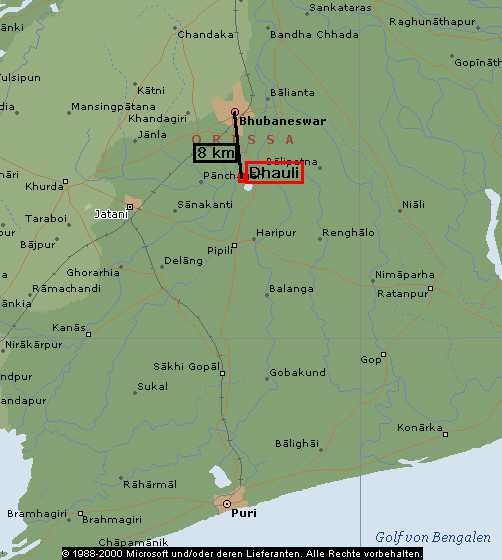
Abb.: Lage von Dhaulī, Pūri District, Orissa (ଓଡ଼ିଆ) - 20°11' N;
85°50' E
[©MS Encarta]
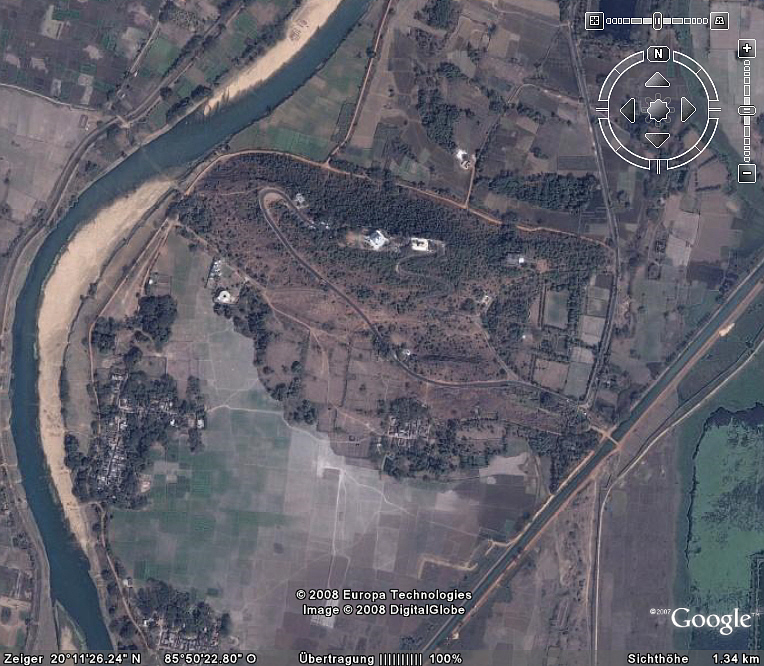
Abb.: Dhaulī Hill
[Bildquelle: ©Google Earth. -- Zugriff am 2008-02-29]
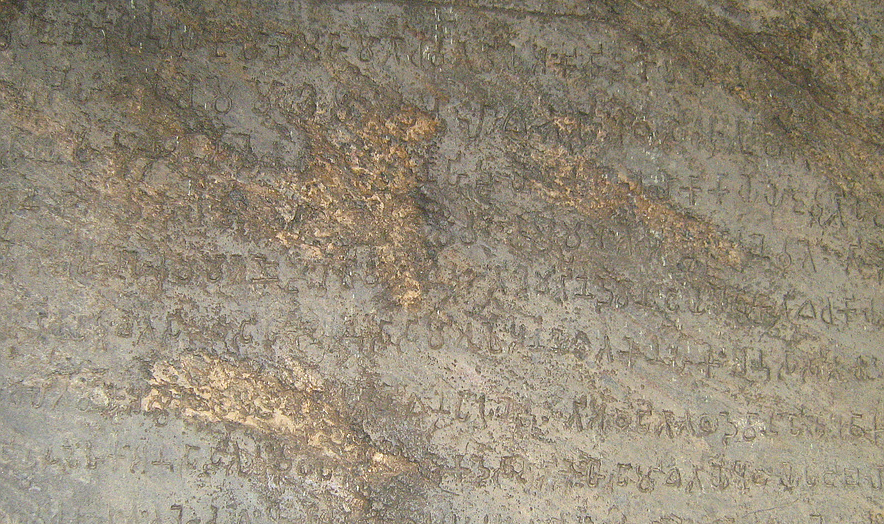
Abb.: Felsenedikt, Dhaulī, Ausschnitt
[Bildquelle: vegdevil. --
http://www.flickr.com/photos/vegdevil/915850174/. -- Zugriff am 2008-02-29.
--
![]()
![]() Creative
Commons Lizenz (Namensnennung, keine kommerzielle Nutzung)]
Creative
Commons Lizenz (Namensnennung, keine kommerzielle Nutzung)]
Hultzsch schreibt über die Felsenedikte in Dhauli:
"V. The Dhauli Rock (Text, p. 84). Dhauli is a village in the Khurdā subdivision of the Purī district, Orissa, about seven miles south of Bhuvanesvar. The inscribed rock near the village was discovered in 1837 by Lieutenant Kittoe, who calls it 'Aswastama'. It 'is situated on a rocky eminence forming one of a cluster of hills, three in number, on the south bank of the Dyah river.'
'The hills before alluded to rise abruptly from the plains and occupy a space of about five furlongs by three; they have a singular appearance from their isolated position, no other hills being nearer than eight or ten miles. They are apparently volcanic, and composed of upheaved breccia with quartzose rock intermixed.'
'The Aswastama is situated on the northern face of the southernmost rock near its summit; the rock has been hewn and polished for a space of fifteen feet long by ten in height, and the inscription deeply cut thereon.'
'Immediately above the inscription is a terrace sixteen feet by fourteen, on the right side of which (as you face the inscription) is the fore half of an elephant, four feet high, of superior workmanship; the whole is hewn out of the solid rock.'
While Prinsep was examining a lithograph of Kittoe's copies, he found that the greater part of the Dhauli inscription was identical with the Gīrnār edicts (JASB, 7. 157). He further ascertained that the Dhauli rock omits edicts XI to XIII of the Gīrnār version, but compensates for them by two separate edicts (id., p. 219). These two he edited with a tentative translation (id., p. 438 ff.), adding Kittoe's lithograph of the whole Dhauli inscription (id., plate 10). As may be seen on this plate, the inscription is arranged in three columns. The middle column contains edicts I to VI, and the right column edicts VII to X and XIV, and below them, within a border of straight lines, the second separate edict, while the first separate edict occupies the whole of the left column.
Cunningham showed that it would be more correct to exchange the two designations 'first and second separate edict': the separate edict engraved in continuation of edict XIV ought to be called No. I, and the one engraved separately on the left No. II. This order is confirmed by the Jaugaḍa rock (No. VII, below) where Prinsep's No. II is actually placed above No. I. But as all editors (besides Kern) have followed Prinseps arrangement, a change of numbers would now lead to much contusion, and it will be sufficient to keep in mind that the separate edict No. I was engraved after No. II.
The two separate edicts were re-edited and translated by Burnouf (Lotus, p. 671ff.) and, from Cunningham's copies, by Kern (JRAS, 1880. 379 ff.). Senart's edition of them was based on estampages by Burgess. The same applies to Bühler's editions of the Dhauli version. He published the whole of it twice: once in German (ZDMG, 39. 489 ff., and 41. 1 ff.) and once in English (ASSI, I. 114 ff.). His second edition is accompanied by photo-lithographs (plates 64-66)."
[Quelle: Inscriptions of Aśoka / new ed. By E. Hultzsch. With 55 plates. -- 1925. -- cxxxi, 260 S. : Ill. ; 35 cm. -- Supersedes: Inscriptions of Aśoka / Prepared by Alexander Cunningham. -- Calcutta, 1887. -- (Corpus inscriptionum indicarum ; vol. I). -- S. XIIIf.]
(A) At the word of Devānāṃpriya, the
Mahāmātras at
Tosalī, (who are) the judicial officers of the city, have to be told (thus).
(B) Whatever I recognize (to be right), that I strive to carry out by deeds, and
to accomplish by (various) means.
(C) And this is considered by me the principal means for this object, viz. (to
give) instruction to you.
(D) For you are occupied with many thousands of men, with the object of gaining
the affection of men.
(E) All men are my children.
(F) As on behalf of (my own) children I desire that they may be provided with
complete welfare and happiness in this world and in the other world, the same I
desire also on behalf of [all] men.
(G) And you do not learn how far this (my) object reaches.
(H) Some single person only learns this, (and) even he (only) a portion, (but)
not the whole.
(I) Now you must pay attention to this, although you are well provided for.
(J) It happens in the administration (of justice) that a single person suffers
either imprisonment or harsh treatment,
(K) In this case (an order) cancelling the imprisonment is (obtained) by him
accidentally, while [many] other people continue to suffer.
(L) In this case you must strive to deal (with all of them) impartially.
(M) But one fails to act (thus) on account of the following dispositions: envy,
anger, cruelty, hurry, want of practice, laziness, (and) fatigue.
(N) (You) must strive for this, that these dispositions may not arise to you.
(O) And the root of all this is the absence of anger and the avoidance of hurry.
(P) He who is fatigued in the administration (of justice), will not rise; but
one ought to move, to walk, and to advance.
(Q) He who will pay attention to this, must tell you: 'See that (you) discharge
the debt (which you owe to the king); such and such is the instruction of Devānāṃpriya.'
(R) The observance of this produces great fruit, (but its) non-observance (becomes)
a great evil.
(S) For if one fails to observe this, there will be neither attainment of heaven
nor satisfaction of the king.
(T) For how (could) my mind be pleased if one badly fulfils this duty ?
(U) But if (you) observe this, you will attain heaven, and you will discharge
the debt (which you owe) to me.
(V) And this edict must be listened to (by all) on (every day of) the
constellation Tishya.
(W) And it may be listened to even by a single (person) also on frequent (other)
occasions between (the days of) Tishya.
(X) And if (you) act thus, you will be able to fulfil (this duty).
(Y) For the following purpose has this rescript been written here, (viz.) in
order that the judicial officers of the city may strive at all times (for this),
[that] neither undeserved fettering nor undeserved harsh treatment are happening
to [men].
(Z) And for the following purpose I shall send out every five years [a Mahāmātra]
who will be neither harsh nor fierce, (but) of gentle actions, (viz. in order to
ascertain)
whether (the judicial officers), paying attention to this object,.....are acting
thus, as
my instruction (implies).
(AA) But from Ujjayinī also the prince (governor) will send out for the same
purpose.....a person of the same description, and he will not allow (more than)
three years to pass (without such a deputation).
(BB) In the same way (an officer will be deputed) from Takshaśilā also.
(CC) When.....these Mahāmātras will set out on tour, then, without neglecting
their own duties, they will ascertain this as well, (viz.) whether (the judicial
officers) are carrying out this also thus, as the instruction of the king (implies).
(A) At the word of Devānāṃpriya, the prince (governor) and
the Mahāmātras at Tosalī have to be told (thus).
(B) Whatever I recognize (to be right), that..........and to accomplish by
(various) means.
(C) And this is considered by me the principal means for this object, viz.
...........to you.
(D)..........my.....
(E) As on behalf of (my own) children I desire that they may be provided with
complete welfare and happiness in this world and in the other world, thus..........
(F) It might occur to (my) unconquered borderers (to ask): 'What does the king
desire with reference to us ?'
(G) [This] alone is my wish with reference to the borderers, that they may learn
that Devānāṃpriya..........that they may not be afraid of me, but may have
confidence (in me); that they may obtain only happiness from me, not misery;
that they may [learn] this, that Devānāṃpriya will forgive them what can be
forgiven ; that they may (be induced) by me (to) practise morality; (and) that
they may attain (happiness in) this world and (in) the other world
(H) For the following purpose I am instructing you, (viz. that) I may discharge
the debt (which I owe to them) by this, that I instruct (you) and inform (you)
of (my) will, i. e. my unshakable resolution and vow.
(I) Therefore, acting thus, (you) must fulfil (your) duty and must inspire
confidence to them, in order that they may learn that Devānāṃpriya is to them
like a father, that Devānāṃpriya loves them like himself, and that they are to
Devānāṃpriya like (his own) children.
(J) Therefore, having instructed (you), and having informed you of (my) will, I
shall have (i. e. entertain) officers in (all) provinces for this object.
(K) For you are able to inspire confidence to those (borderers) and (to secure
their) welfare and happiness in this world and in the other world.
(L) And if (you) act thus, you will attain heaven, and will discharge the debt (which
you owe) to me.
(M) And for the following purpose has this rescript been written here, (viz.) in
order that the Mahāmātras may strive at all times to inspire confidence to those
borderers (of mine) and (to induce them) to practise morality.
(N) And this rescript must be listened to (by all) every four months on (the day
of) the constellation Tishya.
(O) But if desired, it may be listened to even by a single (person) also on
frequent (other) occasions between (the days of) Tishya.
(P) If (you) act thus, you will be able to carry out (my orders).
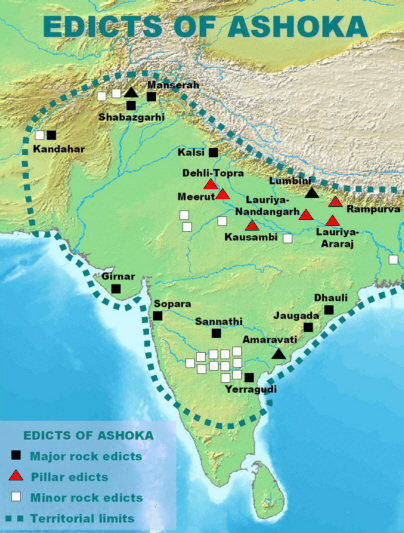
Abb.: Ungefähre Lage der (ursprünglichen) Standorte der großen Säulenedikte
[Bildquelle: Wikipedia, GNU FDLicense]
Die großen Säulenedikte befinden/befanden sich auf Säulen in
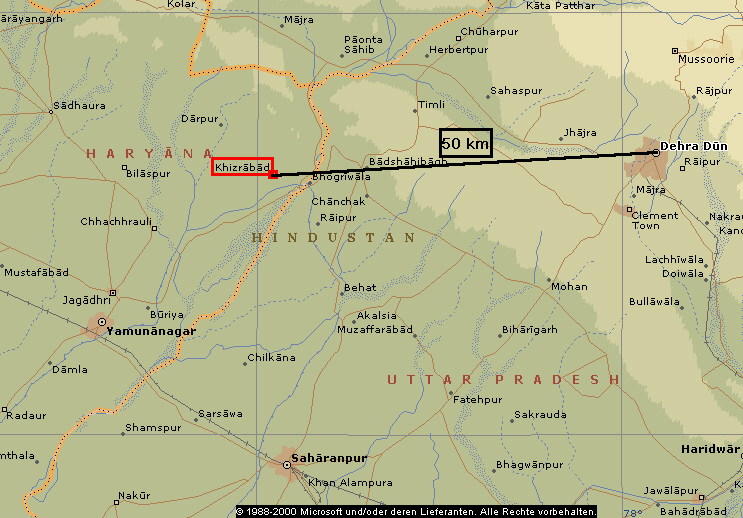
Abb.: Lage von Khizrābād, Haryana, in dessen Nähe sich die Säule von Toprā
ursprünglich befunden haben soll
[©MS Encarta]
Hultzsch schreibt über die Säulenedikte von Delhi-Toprā:
"SECOND PART: THE PILLAR-EDICTS This term is meant to comprise the Aśoka inscriptions on the Delhi-Toprā pillar and on the five other pillars which bear six of the seven edicts inscribed on it. The minor pillar-inscriptions will be treated separately in the third part. The ' Queen's edict' and the ' Kauśāmbī edict', however, are included in the second part, because they are inscribed on the Allahabad-Kosam column which bears also six of the chief pillar-edicts.
I. The Delhi-Toprā Pillar (Text, p. 119).
This famous monument 'is a single shaft of pale pinkish sandstone, 42 feet 7 inches in length, of which the upper portion, 35 feet in length, has received a very high polish, while the remainder is left quite rough.' It used to be known by the names of 'Bhīmasena's pillar', 'Golden pillar',' Fīrōz Shāh's pillar', and 'Delhi-Siwālik pillar'. Shams-i Sirāj, a historian of Firōz Shāh (A. D. 1351-88), informs us that it stood originally 'in the village of Tobra, in the district of Sālaura and Khizrābād, in the hills'; that Sultan Firōz had it carried to Delhi; and that he erected it again on the top of his palace at Firōzābād. From Tobra near Khizrābād, which was ninety kōs from Delhi, the column was carried on a truck with forty-two wheels to the bank of the Jamnā, whence it was floated down the river to Firōzābād (Delhi) on a number of large boats.
Cunningham (Arch. Reports, 14. 78 f.) identified the village of Tobra, where the pillar stood originally, with the present Toprā, on the direct line between Ambālā and Sirsāvā, eighteen miles to the south of Sādhorā, and twenty-two miles to the south-west of Khizrābād. The pillar is standing to the present day on the roof of the three-storied citadel (koṭla) of Firōz Shāh outside the 'Delhi Gate' to the south-east of modern Delhi. An elevation of the building, with the pillar on the top of it, was published in 1788 in the first volume of the Asiatic Researches, p. 379, and a sketch of it in 1803 in vol. 7, p. 175, plate 4.
The Delhi-Toprā. pillar bears seven edicts of Aśoka, of which the last and longest is unique, while other specimens of the first six edicts have been discovered elsewhere. The first six edicts and the eleven first lines of the seventh edict are arranged in four columns on the north, west, south, and east faces of the pillar; the eleven remaining lines of the seventh edict run all round the pillar.
Besides the Aśoka edicts and several minor records of pilgrims and travellers, the pillar bears three short inscriptions of the Chāhamāna Vīsaladeva of Śākambarī, son of Ānnalladeva (EI, 9. 67, n. 5), dated A. D. 1164, which have been edited last by Kielhorn from Fleet's impressions (IA, 19. 215 ff.).
The Delhi-Toprā pillar-inscription is the first record of Aśoka that was read and translated in 1837 by Prinsep (JASB, 6. 566 ff.). Facsimiles of this inscription had been in the possession of the Asiatic Society of Bengal 'since its very foundation, without any successful attempt having been made to decipher them' (id., p. 566).
'On searching the Society's portfolio' Prinsep 'found the five original manuscript plates of Captain Hoare, whence the engravings published in the Researches seem to have been copied.'
'I found also two much larger drawings of the first and last inscription of the series, apparently of the actual dimensions.—These I suppose to have been the originals presented to Sir William Jones by Colonel Polier, and therefore of themselves venerable for their antiquity!' (id., p. 567).
The ingenious manner in which Prinsep succeeded in deciphering the ancient Brāhmī alphabet deserves to be recorded here in his own words:
'In laying open a discovery of this nature, some little explanation is generally expected of the means by which it has been attained. Like most other inventions, when once found it appears extremely simple; and, as in most others, accident, rather than study, has had the merit of solving the enigma which has so long baffled the learned.'
'While arranging and lithographing the numerous scraps of facsimiles for Plate XXVII, I was struck at their all terminating with the same two letters, dānaṃ. Coupling this circumstance with their extreme brevity and insulated position, which proved that they could not be fragments of a continuous text, it immediately occurred [to me] that they must record either obituary notices, or more probably the offerings and presents of votaries, as is shown to be the present custom in the Buddhist temples of Ava; where numerous dhvajas or flag-staffs, images, and small chaityas are crowded within the enclosure, surrounding the chief cupola, each bearing the name of the donor. The next point noted was the frequent occurrence of the letter sa, already set down incontestably as s, before the final word:—now this I had learnt from the Saurāshṭra coins, deciphered only a day or two before, to be one sign of the genitive case singular, being the ssa of the Pali, or sya of the Sanskrit. "Of so and so the gift", must then be the form of each brief sentence; and the vowel ā and Anusvāra led to the speedy recognition of the word dānaṃ (gift), teaching me the very two letters, d and n, most different from known forms, and which had foiled me most in my former attempts. Since 1834 also my acquaintance with ancient alphabets had become so familiar that most of the remaining letters in the present examples could be named at once on re-inspection. In the course of a few minutes I thus became possessed of the whole alphabet, which I tested by applying it to the inscription on the Delhi column' (id., p. 460 f.).
The first four edicts were examined by Burnouf in his Lotus, and the fourth and sixth by Kern in his Jaartelling. Senart's edition and translation of the Delhi-Toprā pillar-edicts in his Inscriptions de Piyadasi (2. 1 ff.) were based on Cunningham's eye-copies. In 1884 Fleet issued excellent photo-lithographs, to which Bühler added transcripts in the Nāgarī character (IA, 13. 306 ff.), and which were utilized in Sir George Grierson's English translation of Senart's French article (IA, vols. 17 and 18). Finally Bühler edited and translated the seven pillar-edicts twice, in German (ZDMG, vols. 45 and 46) and in English (EI, 2. 245 ff.)."
[Quelle: Inscriptions of Aśoka / new ed. By E. Hultzsch. With 55 plates. -- 1925. -- cxxxi, 260 S. : Ill. ; 35 cm. -- Supersedes: Inscriptions of Aśoka / Prepared by Alexander Cunningham. -- Calcutta, 1887. -- (Corpus inscriptionum indicarum ; vol. I). -- S. XVff.]
(A) King Devānāṃpriya Priyadarśin
speaks thus.
(B) This rescript on morality was caused to be written by me (when I had been)
anointed twenty years.
(C) (Happiness) in this (world) and in the other (world) is difficult to secure
without great love of morality, careful examination, great obedience, great fear
(of sin), (and) great energy.
(D) But indeed by my instruction this regard for morality and love of morality
have been promoted day by day and will progress still (more).
(E) And my agents also, both the high ones and the low ones, and those of middle
rank, are conforming to and practising (morality), (and are thus) able to stir
up fickle (persons).
(F) In the same way the Mahāmātras of the borderers also (are acting).
(G) For (their) instruction (is) this, viz. to protect according to morality, to
dispose according to morality, to cause pleasure according to morality, (and)
to guard (their speech) according to morality.
(A) King Devānāṃpriya Priyadarśin
speaks thus.
(B) (To practise) morality is meritorious; but what does morality include ?
(C) (It includes) few sins, many virtuous deeds, compassion, liberality,
truthfulness, (and) purity.
(D) The gift of spiritual insight also has been bestowed by me in many ways.
(E) On bipeds and quadrupeds, on birds and aquatic animals various benefits have
been conferred by me, (even) to the boon of life.
(F) And many other virtuous deeds also have been performed by me.
(G) For the following purpose was this rescript on morality caused to be written
by me, (viz.) in order that (men) might conform to it, and that it might be of
long duration.
(H) And he who will act thus will perform good deeds.
(A) King Devānāṃpriya Priyadarśin
speaks thus.
(B) (Men) regard only (their) virtuous deeds, (thinking): 'This virtuous deed
has been performed by me.'
(C) They do not at all regard (their) evil deeds, (thinking): 'This evil deed
has been performed by me ; this very (act) is called a sin.'
(D) Now this is indeed difficult to recognize.
(E) But indeed this ought to be
regarded thus:
(F) 'These (passions), viz. fierceness, cruelty, anger, pride, envy, are called
sinful. Let me not ruin (myself) by (these) very (passions).'
(G) The following ought to be specially regarded:
(H) 'This (action conduces) to my (happiness) in this (world), that other (action)
to my (happiness) in the other (world).'
(A) King Devānāṃpriya Priyadarśin
speaks thus.
(B) This rescript on morality was caused to be written by me (when I had been)
anointed twenty-six years.
(C) My Lajūkas are occupied with the people, with many hundred thousands of men.
(D) I have ordered that either rewards or punishments are left to their
discretion, in order that the Lajūkas should perform (their) duties confidently
(and) fearlessly, that they should bestow welfare and happiness on the people of
the country, and that they should confer benefits (on them).
(E) They will know how to cause pleasure and to cause pain (to them), and will
exhort the people of the country through those who are devoted to morality, in
order that they may attain (happiness) both in this (world) and in the other
(world).
(F) The Lajūkas also must obey me.
(G) They will also obey the agents who know (my) wishes.
(H) And these (agents) will also exhort those (people), in order that the
Lajūkas may be able to please me.
(I) For, as one feels confident after having entrusted (his) child to an
intelligent nurse, (thinking): 'The intelligent nurse will be able to keep my
child well', so the Lajūkas were appointed by me for the welfare and happiness
of the country-people.
(J) In order that they should perform (their) duties, being fearless, confident,
(and) unperturbed, for this (purpose) I have ordered that either rewards or
punishments are left to the discretion of the Lajūkas.
(K) For the following is to be desired, (viz.) that there should be both
impartiality in judicial proceedings and impartiality in punishments.
(L) And my order (reaches) even so far (that) a respite of three days is granted
by me to persons lying in prison on whom punishment has been passed, (and) who
have been condemned to death.
(M) (In this way) either (their) relatives will persuade those (Lajūkas) to (grant)
their life, or, if there is none who persuades (them), they will bestow gifts or
will undergo fasts in order to (attain happiness) in the other (world).
(N) For my desire is this, that, even when the time (of respite) has expired,
they should attain (happiness) in the other (world).
(O) And various moral practices, self-control, (and) the distribution of gifts
are (thus) promoted among the people.
(A) King Devānāṃpriya Priyadarśin
speaks thus.
(B) (When I had been) anointed twenty-six years, the following animals were
declared by me inviolable, viz. parrots, mainas, the aruṇa, ruddy geese, wild
geese, the nandīmukha, the gelāṭa, bats, queen-ants, terrapins, boneless fish,
the vedaveyaka, the Gaṅgā-pupuṭaka, skate-fish, tortoises and porcupines,
squirrels (?), the sṛmara, bulls set at liberty, iguanas (?), the rhinoceros,
white doves, domestic doves, (and) all the quadrupeds which are neither useful
nor edible.
(C) Those [she-goats], ewes, and sows (which are) either with young or in milk,
are inviolable, and also those (of their) young ones (which are) less than six
months old.
(D) Cocks must not be caponed.
(E) Husks containing living animals must not be burnt.
(P) Forests must not be burnt either uselessly or in order to destroy (living
beings).
(G) Living animals must not be fed with (other) living animals.
(H) Fish are inviolable, and must not be sold, on the three Chāturmāsīs (and) on
the Tishya full-moon during three days, (viz.) the fourteenth, the fifteenth,
(and) the first (tithi), and invariably on every fast-day.
(I) And during these same days also no other classes of animals which are in the
elephant-park (and) in the preserves of the fishermen, must be killed.
(J) On the eighth (tithi) of (every) fortnight, on the fourteenth, on the
fifteenth, on Tishya, on Punarvasu, on the three Chāturmāsīs, (and) on
festivals, bulls must not be castrated, (and) he-goats, rams, boars, and
whatever other (animals) are castrated (otherwise), must not be castrated
(then).
(K) On Tishya, on Punarvasu, on the Chāturmāsīs, (and) during the fortnight of
(every) Chāturmāsī, horses (and) bullocks must not be branded.
(L) Until (I had been) anointed twenty-six years, in this period the release of
prisoners was ordered by me twenty-five (times).
(A) King Devānāṃpriya Priyadarśin
speaks thus.
(B) (When I had been) anointed twelve years, rescripts on morality were caused
to be written by me for the welfare and happiness of the people, (in order that),
not transgressing those (rescripts), they might attain a promotion of morality
in various respects.
(C) (Thinking): ' thus the welfare and happiness of the people (will be secured)',
I am directing my attention not only to (my) relatives, but to those who are
near and far, in order that I may lead them to happiness, and I am instructing (them)
accordingly.
(D) In the same manner I am directing my attention to all classes.
(E) And all the sects have been honoured by me with honours of various kinds.
(F) But this is considered by me (my) principal (duty), viz. visiting (the
people) personally.
(G) (When I had been) anointed twenty-six years, this rescript on morality was
caused to be written by me.
(A) King Devānāṃpriya Priyadarśin
speaks thus.
(B) The kings who were in times past, had this desire, that men might (be made
to) progress by the promotion of morality; but men were not made to progress by
an adequate promotion of morality.
(C) Concerning this, king Devānāṃpriya Priyadarśin speaks thus.
(D) The following occurred to me.
(E) On one hand, in times past kings had this desire, that men might (be made
to) progress by an adequate promotion of morality; (but) on the other hand, men
were not made to progress by an adequate promotion of morality.
(F) How then might men (be made to) conform to (morality) ?
(G) How might men (be made to) progress by an adequate promotion of morality ?
(H) How could I elevate them by the promotion of morality ?
(I) Concerning this, king Devānāṃpriya Priyadarśin speaks thus.
(J) The
following occurred to me.
(K) I shall issue proclamations on morality, (and) shall order instruction in
morality (to be given).
(L) Hearing this, men will conform to (it), will be elevated, and will (be made
to) progress considerably by the promotion of morality.
(M) For this purpose proclamations on morality were issued by me, (and) manifold
instruction in morality was ordered (to be given), [in order that those agents]
(of mine) too, who are occupied with many people, will exhort (them) and will
explain (morality to them) in detail.
(N) The Lajūkas also, who are occupied with many hundred thousands of men, —these
too were ordered by me: 'In such and such a manner exhort ye the people who are
devoted to morality'.
(O) Devānāṃpriya Priyadarśin speaks thus.
(P) Having in view this very (matter), I have set up pillars of morality,
appointed Mahāmātras of morality, (and) issued [proclamations] on morality.
(Q)
King Devānāṃpriya Priyadarśin speaks thus.
(R) On the roads banyan-trees were caused to be planted by me, (in order that)
they might afford shade to cattle and men, (and) mango-groves were caused to be
planted.
(S) And (at intervals) of eight kos wells were caused to be dug by me, and
flights of steps (for descending into the water) were caused to be built.
(T) Numerous drinking-places were caused to be established by me, here and there,
for the enjoyment of cattle and men.
(U) [But] this so-called enjoyment (is) [of little consequence].
(V) For with various comforts have the people been blessed both by former kings
and by myself.
(W) But by me this has been done for the following purpose: that they might
conform to that practice of morality.
(X) Devānāṃpriya Priyadarśin speaks thus.
(Y) Those my Mahāmātras of morality too are occupied with affairs of many kinds
which are beneficial to ascetics as well as to householders, and they are
occupied also with all sects.
(Z) Some (Mahāmātras) were ordered by me to busy themselves with the affairs of
the Saṃgha; likewise others were ordered by me to busy themselves also with the
Brāhmaṇas (and) Ājīvikas; others were ordered by me to busy themselves also with
the Nirgranthas; others were ordered by me to busy themselves also with various
(other) sects; (thus) different Mahāmātras (are busying themselves) specially
with different (congregations).
(AA) But my Mahāmātras of morality are occupied with these (congregations) as
well as with all other sects.
(BB) King Devānāṃpriya Priyadarśin speaks thus.
(CC) Both these and many other chief (officers) are occupied with the delivery
of the gifts of myself as well as of the queens, and among my whole harem [they
are reporting] in divers ways different worthy recipients of charity both here
and in the provinces.
(DD) And others were ordered by me to busy themselves also with the delivery of
the gifts of (my) sons and of other queens' sons, in order (to promote) noble
deeds of morality (and) the practice of morality.
(EE) For noble deeds of morality and the practice of morality (consist in) this,
that (morality), viz. compassion, liberality, truthfulness, purity, gentleness,
and goodness, will thus be promoted among men.
(FF) King Devānāṃpriya Priyadarśin speaks thus.
(GG) Whatsoever good deeds have been performed by me, those the people have
imitated, and to those they are conforming.
(HH) Thereby they have been made to progress and will (be made to) progress in
obedience to mother and father, in obedience to elders, in courtesy to the aged,
in courtesy to Brāhmaṇas and Śramaṇas, to the poor and distressed, (and) even to
slaves and servants.
(II) King Devānāṃpriya Priyadarśin speaks thus.
(JJ) Now this progress of morality among men has been promoted (by me) only in
two ways, (viz.) by moral restrictions and by conversion.
(KK) But among these (two), those moral restrictions are of little consequence;
by conversion, however, (morality is promoted) more considerably.
(LL) Now moral restrictions indeed are these, that I have ordered this, (that)
certain animals are inviolable.
(MM) But there are also many other moral restrictions which have been imposed by
me.
(NN) By conversion, however, the progress of morality among men has been
promoted more considerably, (because it leads) to abstention from hurting living
beings (and) to abstention from killing animals.
(OO) Now for the following purpose has this been ordered, that it may last as
long as (my) sons and great-grandsons (shall reign and) as long as the moon and
the sun (shall shine), and in order that (men) may conform to it
(PP) For if one conforms to this, (happiness) in this (world) and in the other (world)
will be attained
(QQ) This rescript on morality was caused to be written by me (when I had been)
anointed twenty-seven years.
(RR) Concerning this, Devānāṃpriya says.
(SS) This rescript on morality must be engraved there, where either stone
pillars or stone slabs are (available), in order that this may be of long
duration.
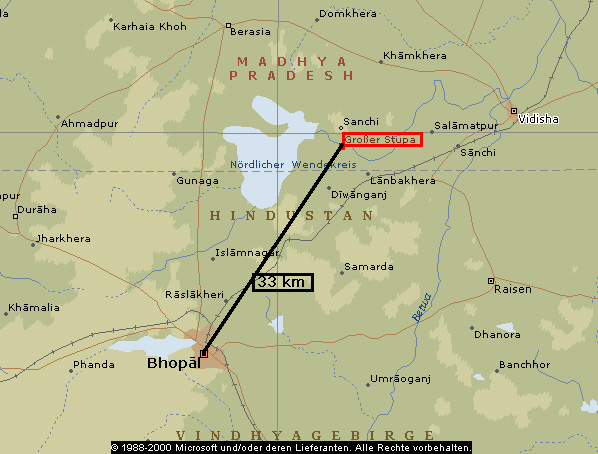
Abb.: Ursprüngliche Lage der Säule von Sanchi
[©MS Encarta]
Hultzsch schreibt über diese Säule:
"I. The Sāṃchī Pillar (Text, p. 160). Sāṃchī is an ancient site in the Bhopāl State, Central India, 5 ½ miles from Bhīlsā and about ¾ mile from the Sanchi railway station. The Aśoka pillar 'is only a fragment of a large polished shaft; but near it there still lies a beautiful broken capital crowned by four lions, which, no doubt, once surmounted it,' It is now lying in the jungle; but apparently it stood originally near the south gate of the great Sāṃchī Stūpa.
The beginning of the inscription on the pillar is lost, and the first preserved line is badly damaged. A facsimile was published by Burgess in EI, 2. 369. The record was edited and translated by Bühler (id., p. 366 f.) and by Boyer (IA (10), 10. 123ff. and 141), and re-examined by myself (JRAS, 1911. 167 ft., and 1912. 1055 f.)."
[Quelle: Inscriptions of Aśoka / new ed. By E. Hultzsch. With 55 plates. -- 1925. -- cxxxi, 260 S. : Ill. ; 35 cm. -- Supersedes: Inscriptions of Aśoka / Prepared by Alexander Cunningham. -- Calcutta, 1887. -- (Corpus inscriptionum indicarum ; vol. I). -- S. XXI.]
Übersetzung von Hultzsch:
(A)..........
(B)..........[cannot] be divided.
(C) The Saṃgha both of monks and of nuns is made united as long as (my) sons and
great-grandsons (shall reign, and) as long as the moon and the sun (shall shine).
(D) The monk or nun who shall break up the Saṃgha, must be caused to put on
white robes and to reside in a non-residence.
(E) For my desire is that the Saṃgha may be united (and) of long duration.
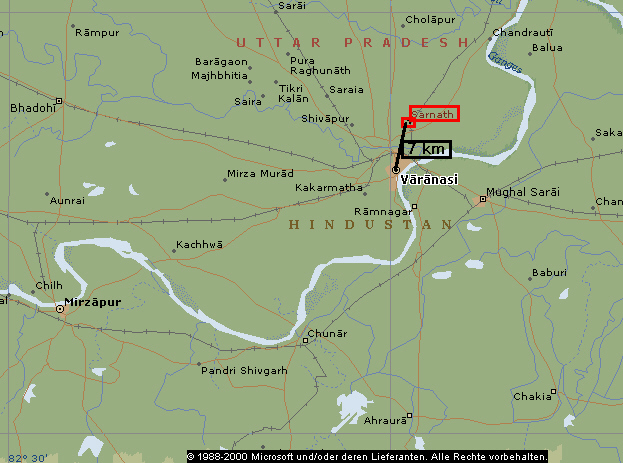
Abb.: Lage von Sārnāth
[©MS Encarta]
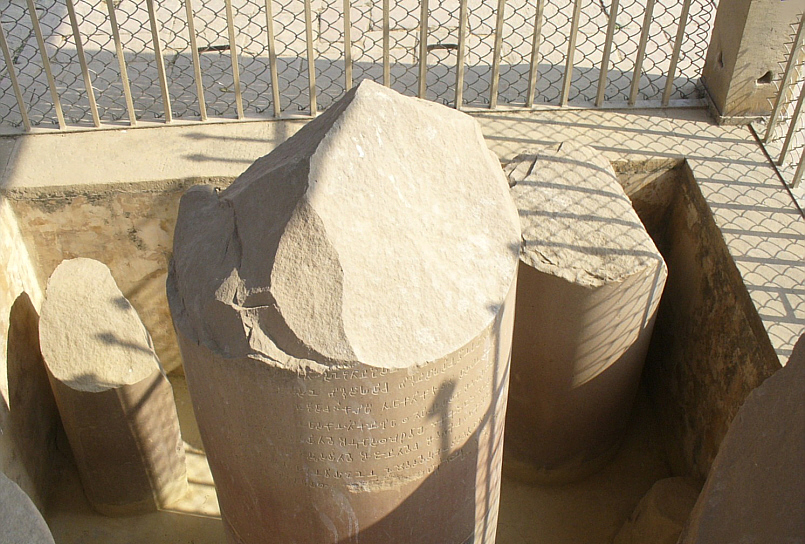
Abb.: Rest der Säule, Sārnāth
[Bildquelle: Wikipedia, Public domain]
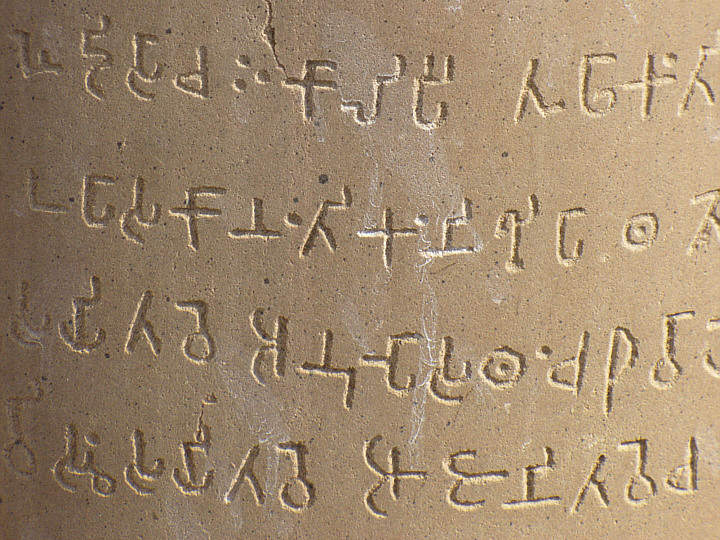
Abb.: Detail der Säuleninschrift
[Bildquelle: Wikipedia, Public domain]
Hultzsch schreibt über diese Säule:
"II. The Sārnāth Pillar (Text, p. 161). Sārnāth, about 3 1/2 miles to the north of Benares, is believed to be the site of one of the most memorable events in the career of the Buddha: it adjoins the Migadāya (i. e.'deer-park') at Isipatana in which he preached his first sermon. Here Mr. F. O. Oertel discovered a broken pillar of polished sandstone which bears an edict of Aśoka. He found also the former capital of the column, which 'is surmounted by four magnificent lions standing back to back, and in their middle was a large stone wheel, the sacred dharmachakra symbol', of which only fragments remain. 'The lions stand on a drum with four animal figures carved on it, viz. a lion, an elephant, a bull, and a horse, placed between four wheels. The upper part of the capital is supported by an elegantly shaped Persepolitan bell-shaped member.'
In the opinion of a competent judge 'it would be difficult to find in any country an example of ancient animal sculpture superior or even equal to this beautiful work of art, which successfully combines realistic modelling with ideal dignity, and is finished in every detail with perfect accuracy.'
The Chinese traveller, Hiuen Tsiang, saw on the site of the Migadāya a stone pillar which stood in front of a Stūpa built by Aśokarāja, and which was about 70 feet high.
As Oertel (op. cit, p. 69) has calculated the actual height of the Sārnāth pillar at about 37 feet above ground, Hiuen Tsiang seems to have overestimated its height, unless he refers to a different pillar.
Unfortunately the three top lines of the inscription are broken away, and the fourth line is badly damaged. But Oertel succeeded in recovering three inscribed fragments which, as Professor Vogel has proved, contain the two first aksharas of each of lines 1-3, and the end of lines 3 and 4 (EI, 8. 166 f.). The remainder of the inscription was found in situ underground, and is in a state of nearly perfect preservation.
The stump of the pillar bears also two short records of a later date : an inscription of king Aśvaghosha which is engraved in continuation of the last line of the Aśoka edict, and a Buddhist inscription in early Gupta characters above the Aśvaghosha epigraph. These three records were first published, with collotypes, by Vogel in EI, 8. 166 ff., and the Aśoka edict was re-edited by Boyer (JA (10), 10. 119 ff.), Senart (CR, 1907. 25 ff.), and Venis (JPASB, 3. 1 ff.). See also my remarks in JRAS, 1912. 1053 ff."
[Quelle: Inscriptions of Aśoka / new ed. By E. Hultzsch. With 55 plates. -- 1925. -- cxxxi, 260 S. : Ill. ; 35 cm. -- Supersedes: Inscriptions of Aśoka / Prepared by Alexander Cunningham. -- Calcutta, 1887. -- (Corpus inscriptionum indicarum ; vol. I). -- S. XXIf.]
Übersetzung von Hultzsch:
(A) Devā[nāṃpriya]..........
(B)..........Pāṭa[liputra]..........
(C).....the Saṃgha [cannot] be divided by any one.
(D) But indeed that monk or nun who shall break up the Saṃgha, should be caused
to put on white robes and to reside in a non-residence.
(E) Thus this edict must be submitted both to the Saṃgha of monks and to the
Saṃgha of nuns.
(F) Thus speaks Devānāṃpriya:
(G) Let one copy of this (edict) remain with you deposited in (your) office; and
deposit ye another copy of this very (edict) with the lay-worshippers.
(H) These lay-worshippers may come on every fast-day (posatha) in order to be
inspired with confidence in this very edict; and invariably on every fast-day,
every Mahāmātra (will) come to the fast-day (service) in order to be inspired
with confidence in this very edict and to understand (it).
(I) And as far as your district (extends), dispatch ye (an officer) everywhere
according to the letter of this (edict).
(J) In the same way cause (your subordinates) to dispatch (an officer) according
to the letter of this (edict) in all the territories (surrounding) forts.
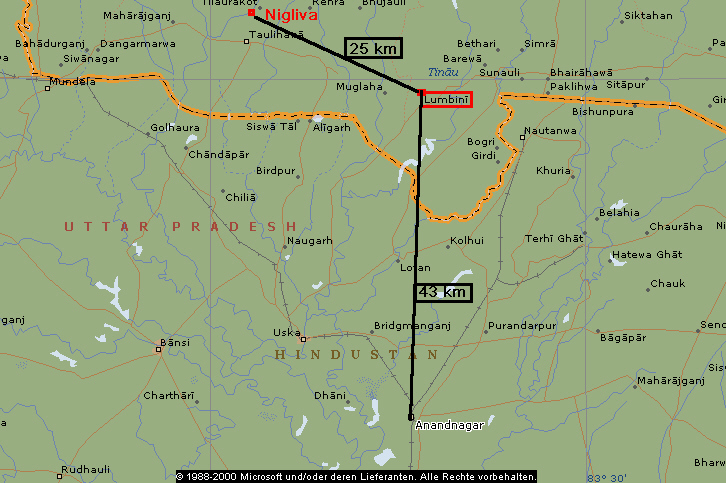
Abb.: Lage von Lumbini und Nigliva
[©MS Encarta]
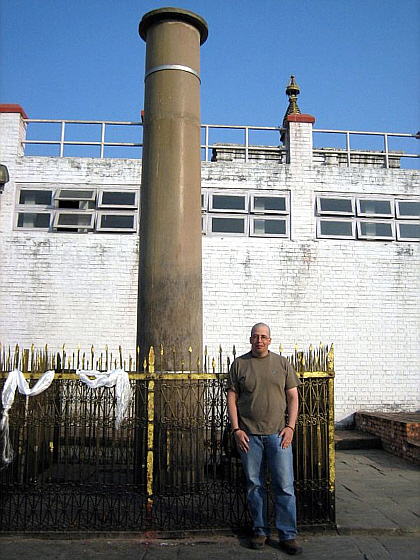
Abb.: Aśoka-Säule in Lumbini
[Bildquelle: Prince Roy. --
http://www.flickr.com/photos/princeroy/97931135/. -- Zugriff am 2008-03-01.
--
![]() Creative
Commons Lizenz (Namensnennung)]
Creative
Commons Lizenz (Namensnennung)]
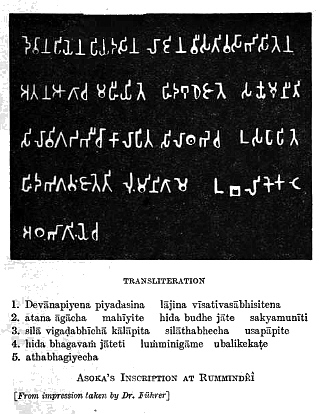
Abb.: Die Inschrift auf der Säule von Lumbini
[Bildquelle: Smith, Vincent Arthur <1848-1920>: Aśoka, the Buddhist emperor of India. -- 3d ed., rev. and enl. -- Oxford : Clarendon Press, 1920. -- 278 S. Ill. ; 19 cm. -- S. 221.]
Hultzsch schreibt über diese Säule:
"III. The Rummindeī Pillar (Text, p. 164). In December 1896 Dr. Führer found a pillar bearing an inscription of Aśoka about thirteen miles south-east of the Nigālī Sāgar pillar (below, No. IV) in the Nepalese Tarāī. The pillar stands near the shrine of Rummindeī, about a mile to the north of the village of Paṛariyā, which is about two miles north of Bhagvānpur, the head-quarters of the Nepalese tahsīl of that name, and about five miles to the north-east of Dulhā in the British district of Bastī.
The new Aśoka pillar is a mere stump, but still in situ and surrounded by a brick railing. 'It is of hard sandstone of the usual yellowish colour, and rises to a height of 21 feet or so.' The inscription on it was edited, with facsimile, by Bühler in 1898, and records that Aśoka visited the spot and erected the pillar 'because the Buddha Śākyamuni was born here', and that the king exempted the village of Luṃmini from taxes.
Both Luṃmini and the modern name Rummindeī must be identical with the Lumbinī grove, the traditional site of the Buddha's birth. This identification is confirmed by Hiuen Tsiang, who mentions a pillar set up by Aśokarāja in the Lumbinī garden, and near the pillar the 'river of oil ', which is now called Tilār-nadī, i. e. apparently 'the telī's or oilman's river'. He further states that the pillar bore on the top the figure of a horse, and that it had been struck by lightning and broken off in the middle. This agrees with Mukherji's description of the Rummindeī pillar (p. 34). He tells us that 'its upper portion is gone, and of what remains the top is split into two halves, the line of fissure coming down to near the middle height. The capital was of
the usual bell-shaped form, of which the base, broken into two halves, exists.....The stone horse, which crowned the capital, is gone with the upper portion of the shaft'; but it seems to be alluded to in the inscription itself. Finally, the temple of Rummindeī contains an ancient sculpture which represents the nativity of the Buddha (op. cit., plate 24, a). This is an additional piece of evidence in favour of the identity of the locality with the Lumbini-vana."[Quelle: Inscriptions of Aśoka / new ed. By E. Hultzsch. With 55 plates. -- 1925. -- cxxxi, 260 S. : Ill. ; 35 cm. -- Supersedes: Inscriptions of Aśoka / Prepared by Alexander Cunningham. -- Calcutta, 1887. -- (Corpus inscriptionum indicarum ; vol. I). -- S. XXIIf.]
Übersetzung von Hultzsch:
(A) When king Devānāṃpriya Priyadarśin
had been anointed twenty years,
he came himself and worshipped (this spot), because the Buddha Śākyamuni was
born here.
(B) (He) both caused to be made a stone bearing a horse (?) and caused a stone
pillar to be set up, (in order to show) that the Blessed one was born here.
(C) (He) made the village of Luṃmini free of taxes, and paying (only) an eighth
share (of the produce).
Karte der Lage siehe oben bei Lumbini.
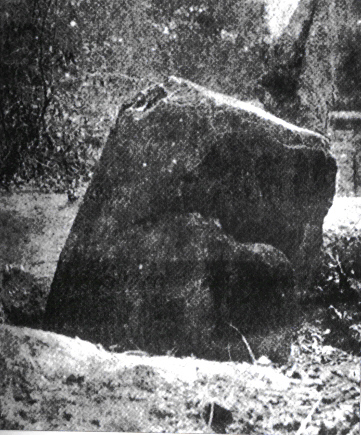
Abb.: Stumpf der Säule von Niglīvā, wie er 1895 von Führer gefunden
wurde
[Bildquelle: Führer, 1897, pl. IV. -- Hier nach Falk, 2006, S. 189]
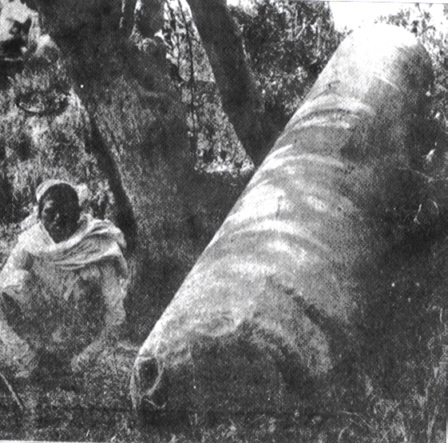
Abb.: Oberteil der Säule von Niglīvā, wie er 1895 von Führer gefunden
wurde
[Bildquelle: Führer, 1897, pl. V. -- Hier nach Falk, 2006, S. 189]
Hultzsch schreibt über diese Säule:
"IV. The Nigālī Sāgar Pillar (Text, p. 165). In March 1895 another Aśoka pillar of polished sandstone was discovered by Führer in the Nepalese Tarāī on the western bank of a large tank called Nigālī Sāgar, about a mile south of Niglīvā. This village lies about thirteen miles north-west of Rummindeī and belongs to the Nepalese tahsīl of Taulivā (about seven miles northwest of Piprāvā in the British district of Basti).
The pillar is now called Nigālī or 'the smoking-pipe' of Bhīmasena. It is not in situ, and only two broken portions of it are preserved. The upper piece is about 14 feet 9½ inches long and bears a few mediaeval drawings and scribblings. The lower portion is about 10 feet long and bears an inscription of Aśoka in four lines; some letters at the beginning of the two last lines are broken away.
The inscription was first edited by Bühler in VOJ, 9. 175 ff., and again, with facsimile, in EI, 5. 1 ff. It records that Aśoka 'enlarged the Stūpa of the Buddha Konākamana to the double (of its original size)', and that later on he visited the spot in person and erected the pillar.
Hiuen Tsiang seems to mention the Nigālī Sāgar pillar. He states that it stood in front of a Stūpa containing relics of Kanakamuni Buddha, that it was surmounted by a lion, was about 20 feet high (which is less than the length of the two preserved pieces combined), bore an inscription, and had been erected by Aśokarāja. The Stūpa referred to by Hiuen Tsiang cannot be traced near the spot where the two portions of the pillar have been found."
[Quelle: Inscriptions of Aśoka / new ed. By E. Hultzsch. With 55 plates. -- 1925. -- cxxxi, 260 S. : Ill. ; 35 cm. -- Supersedes: Inscriptions of Aśoka / Prepared by Alexander Cunningham. -- Calcutta, 1887. -- (Corpus inscriptionum indicarum ; vol. I). -- S. XXIII.]
Übersetzung von Hultzsch:
(A) When king Devānāṃpriya Priyadarśin
had been anointed fourteen years, he enlarged the Stūpa of the Buddha Konākamana
to the double (of its
original size).
(B) And when he had been anointed [twenty] years, he came himself and worshipped
(this spot) [and] caused [a stone pillar to be set up].
Rūpnāth, Jabalpur (जबलपुर) District, Madhya Pradesh (मध्य प्रदेश) - 23°38' N 80°02' E
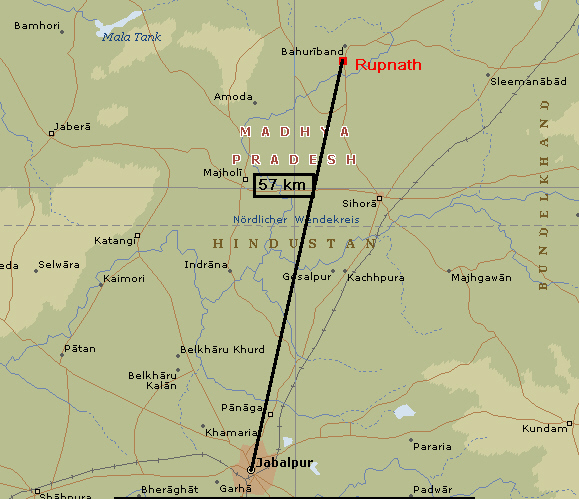
Abb.: Lage von Rūpnāth
[©MS Encarta. Alle Rechte vorbehalten]
Hultzsch über diese Inschrift:
"I. The Rūpnāth Rock-Inscription (Text, p. 166). Rūpnāth is an out-of-the-way place of pilgrimage in the Central Provinces, fourteen miles west of Sleemanabad railway station on the line from Jabalpur to Katni.
'The Rūpnāth rock is a single flinty block of dark-red sandstone lying at the foot of the Kaimur range of hills, just below the fertile plateau of Bahuriband. Here a small stream breaks over the crest of the Kaimur range, and, after three low falls, forms a deep secluded pool at the foot of the scarp. Each of these pools is considered holy, the uppermost being named after Rāma, the next after Lakshmaṇa, and the lowest after Sītā. The spot, however, is best known by the name of Rūpnāth, from a liṅga of Śiva which is placed in a narrow cleft of the rocks on the right.'
'The detached boulder, upon which the edict of Aśoka is inscribed, lies just above the west margin of the lower pool under a great tree, the inscription being upon its flat top and near one edge. The rock is one of many that have fallen at some time or another from the cliffs above, and it is possible that it has fallen since the inscription was cut upon it.'
'The edict of Aśoka is inscribed on the upper surface of the rock, which has been worn quite smooth by people sitting upon it for hundreds of years at the annual fairs. It is now of a very dark dirty-red colour, and the inscription might easily escape observation. The lines follow the undulations of the rock, and are neither straight nor parallel with each other. The inscription is 4½ feet long and 1 foot broad, and consists of six lines, of which the last has only five letters.'
The Rūpnāth edict was copied in 1871-2 by Cunningham (Arch. Reports, 7. 59) and published with a facsimile in 1877 by Bühler (IA, 6. 149ff.), who re-edited it twice afterwards. Senart's treatment of it is included in his Inscriptions de Piyadasi (2.165 ff.) and in Sir George Grierson's translation (IA, 20. 154ff.). Fresh impressions of the inscription were prepared by the late Dr. Bloch."
[Quelle: Inscriptions of Aśoka / new ed. By E. Hultzsch. With 55 plates. -- 1925. -- cxxxi, 260 S. : Ill. ; 35 cm. -- Supersedes: Inscriptions of Aśoka / Prepared by Alexander Cunningham. -- Calcutta, 1887. -- (Corpus inscriptionum indicarum ; vol. I). -- S. XXIIIf.]
Übersetzung von Hultzsch:
(A) Devānāṃpriya speaks thus.
(B) Two and a half years and somewhat more (have passed) since I am openly a
Śākya.
(C) But (I had) not been very zealous.
(D) But a year and somewhat more (has passed) since I have visited the Saṃgha
and have been very zealous.
(E) Those gods who during that time had been unmingled (with men) in Jambudvīpa,
have now been made (by me) mingled (with them).
(F) For this is the fruit of zeal.
(G) And this cannot be reached by (persons of) high rank (alone), (but) even a
lowly (person) is able to attain even the great heaven if he is zealous.
(H) And for the following purpose has (this) proclamation been issued, (that)
both the lowly and the exalted may be zealous, and (that) even (my) borderers
may know (it), (and) that this same zeal may be of long duration.
(I) For, this matter will (be made by me to) progress, and will (be made to)
progress considerably; it will (be made to) progress to at least one and a half.
(J) And cause ye this matter to be engraved on rocks where an occasion presents
itself.
(K) And (wherever) there are stone pillars here, it must be caused to be
engraved on stone pillars.
(L) And according to the letter of this (proclamation) (you) must dispatch (an
officer) everywhere, as far as your district (extends).
(M) (This) proclamation was issued by (me) on tour.
(N) 256 (nights) (had then
been) spent on tour.
Sāsārām (सासाराम)), Rohtās (रोहतास) District, Bihar - 24° 57′ 0″ N, 84° 1′ 48″ E; Decimal 24.95°, 84.03°
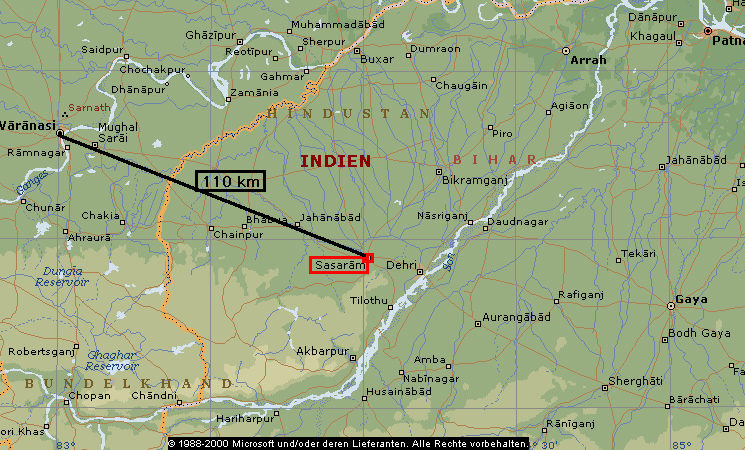
Abb.: Lage von Sasaram
[©MS Encarta. Alle Rechte vorbehalten]
Hultzsch über diese Inschrift:
"II. The Sahasrām Rock-Inscription (Text, p. 169). Sahasrām is a town and the head-quarters of a subdivision in the Shāhābād district, South Bihār. 'About two miles to the east of the town rises one of the last spurs of the Kaimur range of hills called Chandan-Pīr, after a Muhammadan saint, who took up his abode on the top of the hill.'
The edict of Aśoka 'is found in an artificial cave a short distance below, which is generally known as the Chirāghdān or 'lamp' of the saint. The roof of the cave is formed by a large projecting mass of rock that has most effectually preserved the greater part of the inscription, which is in excellent order, except in three or four places where the rock has peeled off. The entrance, which is only 4 feet high, is to the west between two built walls. By making an opening in one of these walls, my assistant, Mr. Beglar, obtained a good photograph of the inscription.'
The Sahasrām edict was published three times by Bühler and twice by Senart along with the Rūpnāth one (No. I, above). In editing it the third time (IA, 22. 299), Bühler noted that Beglar's photograph still shows a number of letters which have since disappeared owing to the disintegration of the rock, and which are already missing in Fleet's facsimile (loc cit). To the kindness of Sir John Marshall I owe a copy of this valuable photograph, which I have utilized for my transcript of the text."
[Quelle: Inscriptions of Aśoka / new ed. By E. Hultzsch. With 55 plates. -- 1925. -- cxxxi, 260 S. : Ill. ; 35 cm. -- Supersedes: Inscriptions of Aśoka / Prepared by Alexander Cunningham. -- Calcutta, 1887. -- (Corpus inscriptionum indicarum ; vol. I). -- S. XXIV.]
Übersetzung von Hultzsch:
(A) Devānāṃpriya [speaks] thus.
(B)..........years since I am a lay-worshipper (upāsaka).
(C) But (I had) not been very zealous.
(D) A year and somewhat more (has passed) since..........
(E) And men in Jambudvīpa, being during that time unmingled with the gods, have
(now) been made (by me) mingled with the gods.
(F) [For] this is the fruit [of zeal].
(6).....cannot be reached by (persons of) high rank alone, (but) even a lowly
(person) is able to attain even the great heaven if he is zealous.
(H) Now, for the following purpose (has) this proclamation (been issued), (that)
both the lowly and the exalted may be zealous, and (that) even (my) borderers
may know (it), and (that this) zeal may be of long duration.
(I) And this matter will (be made by me to) progress, and will (be made to)
progress even considerably; it will (be made to) progress to one and a half, to
at least one and a half.
(J) And this proclamation (was issued by me) on tour.
(K) Two hundred and fifty-six nights (had then been) spent on tour,—(in figures)
256.
(L) And cause ye this matter to be engraved on rocks.
(M) And where there are stone pillars here (in my dominions), there also cause
(it) to be engraved.
Bairāṭ, Jaipur (जयपुर) District, Rajasthan (राजस्थान) -- 27°28' N 76°13' E.
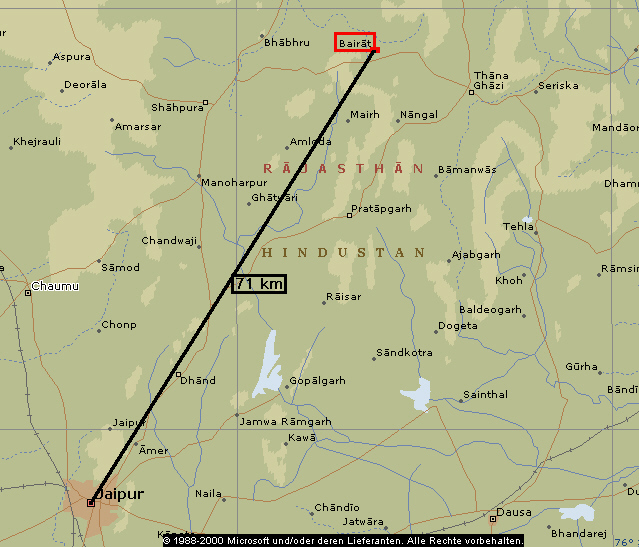
Abb.: Lage von Bairāṭ
[©MS Encarta. Alle Rechte vorbehalten]
Hultzsch über diese Inschrift:
"IV. The Calcutta-Bairāṭ Rock-Inscription (Text, p. 172). The block which bears this very interesting and valuable record is now preserved in Calcutta by the Asiatic Society of Bengal. It was discovered in 1840 by Captain Burt 'upon a hill lying adjacent to' Bairāṭ, the town near which some years later Carlleyle found the preceding inscription (No. III). Burt reported that he found the inscription 'on a hard, grey granite block, irregularly shaped, and measuring about two feet in two of its dimensions, and a foot and a half in the third' (JASB, 9. 616). His copy of the inscription was lithographed by Captain Kittoe, and transcribed and translated by the same 'with the aid of the learned Pandit Kamala Kanta' (id., p. 617 and plate).
Burt's copy formed the basis of the editions of Burnouf (Lotus, p. 710 ff.), Kern (Jaartelling, p. 32 ff.), and Wilson (JRAS, 16. 357 ff., with lithograph). Senart edited the record in his Inscriptions de Piyadasi, 2. 197 ff., and published a revised edition of it, from an estampage by Burgess, in IA, 20. 165 ff. A photograph of Burgess' estampage appeared in JA (8), 9. 498.
As Burt had stated that Bairāṭ was six kos distant from 'Bhabra' (JASB, 9. 616), the inscription has been styled generally 'the Bhabra edict'. But this name implies a double mistake: the town from which it is derived is not called 'Babra', but Bhābrū, and the latter is twelve miles distant from Bairāṭ, the finding-place of the block. According to Cunningham (Arch. Reports, 2. 247), 'the hill on which the inscription was found forms a conspicuous object about one mile to the south-west of the town [of Bairāṭ]. It is about 200 feet high, and is still known by the name of Bījak-Pahaṛ or "inscription hill".' It is covered with ruins which Cunningham (id., p. 248) took to be the remains of two Buddhist monasteries.
'The inscription stone originally lay, I am told; near the shrine of Hanūmān below the rock known as top or "cannon", on the first or lower platform on the summit of the hill.'
In order to distinguish this inscription from the preceding one (No. III), I propose to call it 'the Calcutta-Bairāṭ rock-inscription'."
[Quelle: Inscriptions of Aśoka / new ed. By E. Hultzsch. With 55 plates. -- 1925. -- cxxxi, 260 S. : Ill. ; 35 cm. -- Supersedes: Inscriptions of Aśoka / Prepared by Alexander Cunningham. -- Calcutta, 1887. -- (Corpus inscriptionum indicarum ; vol. I). -- S. XXV.]
Übersetzung von Hultzsch:
(A) The Māgadha king Priyadarśin,
having saluted the Saṃgha, hopes they are both well and comfortable.
(B) It is known to you, Sirs, how great is my reverence and faith in the Buddha,
the Dharma, (and) the Saṃgha.
(C) Whatsoever, Sirs, has been spoken by the blessed Buddha, all that is quite
well spoken.
(D) But, Sirs, what would indeed appear to me (to be referred to by the words of
the scripture) : 'thus the true Dharma will be of long duration', that I feel
bound to declare.
(E) The following expositions of the Dharma, Sirs, (viz.) (1) the
Vinaya-samukasa, (2) the Aliya-vasas, (3) the Anāgata-bhayas, (4) the
Muni-gāthās, (5) the Moneya-sūta, (6) the Upatisa-pasina, and (7) the
Lāghulovāda which was spoken by the blessed Buddha concerning falsehood,— I
desire, Sirs, that many groups of monks and (many) nuns may repeatedly listen to
these expositions of the Dharma, and may reflect (on them).
(F) In the same way both laymen and laywomen (should act).
(G) For the following
(purpose), Sirs, am I causing this to be written, (viz.) in order that they may
know my intention.
Maski, Raichur (ರಾಯಚೂರು) District, Karnataka (ಕನಾ೯ಟಕ) -- 15°57' N 76°39' E
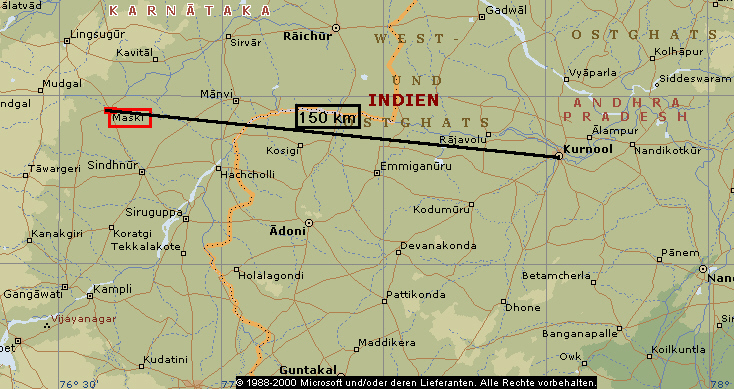
Abb.: Lage von Maski
[©MS Encarta. Alle Rechte vorbehalten]
Hultzsch über diese Inschrift:
"V. The Maski Rock-Inscription (Text, p. 174). Another, damaged, version of the Rūpnāth, Sahasrām, and Bairāṭ edicts was discovered on January 27, 1915, by Mr. C. Beadon, a gold-mining engineer, in the neighbourhood of Maski, a village in the Lingsugur tāluka of the Raichur district of the Nizam's Dominions, about forty-six miles west-south-west from Raichur. I am indebted to Rao Bahadur H. Krishna Sastri for the subjoined note on Maski:
'By enquiries made, at the place, I gather that the spelling of the village named Maski is different with different communities. The masses of illiterate agriculturists pronounce it Maśgi or Maśigi; the Brāhmīn classes call it Maski, and the Muhammadans Masgi. A Chālukya inscription of the time of Jagadekamalla (Śaka 949) calls the place Rājadhāni piriya-Mosaṃgi, i.e. "the royal residence of great Mosaṅgi". Another inscription of the same king in the village refers to that quarter as the Brahmapurī of Mosaṃgi. A later record of the Yādava king Siṅghaṇa of the thirteenth century calls the place again Rājadhāni piriya-Mosaṃgi. In two other inscriptions of the place belonging to the reigns of Achyutarāya and Sadāśivarāya, its name is mentioned as Mosage, the chief town of Mosage-nāḍu.'
To these remarks we may add that Mosaṅgi, the ancient form of the name of Maski, suggests its identity with the battle-field of Muśaṅgi, where, according to Tamil records, the Chālukya king Jayasiṃha II was defeated by Rājendra-Choḷa I.
A careful transcript and translation of the Maski inscription (with plates) was published by H. Krishna Sastri, who describes the site as follows:
'The cavern in which the inscribed boulder stands is formed of a huge rock resting at various points of its periphery on other smaller ones, some of which are partly buried in the gravelly soil below. The boulder, which is a block of crystalline grey granite of irregular shape, stands at the southern entrance into the cavern, with the writing facing inwards. The surface of the boulder has peeled off at various places, sometimes right up to the depth to which the letters were incised, and measures roughly 8 feet 9 inches by 5 feet' (p. 2).
In the year 1916, the third of the great war, Fleet drew attention to the new inscription in JRAS, 1916. 572 ff.; Senart examined it in detail in JA (11), 7. 425 ff.; and I, having received a copy of Krishna Sastri's article from my friend Konow, re-published the text in ZDMG, 70. 539 ff.
The chief interest of the Maski inscription consists in the fact that the king is here called not only Devānāṃpriya, but in addition to it Aśoka,—a name which was hitherto known only from Buddhist literature and from the Purāṇas."
[Quelle: Inscriptions of Aśoka / new ed. By E. Hultzsch. With 55 plates. -- 1925. -- cxxxi, 260 S. : Ill. ; 35 cm. -- Supersedes: Inscriptions of Aśoka / Prepared by Alexander Cunningham. -- Calcutta, 1887. -- (Corpus inscriptionum indicarum ; vol. I). -- S. XXVf.]
Übersetzung von Hultzsch:
(A) [A proclamation] of Devānāṃpriya
Aśoka.
(B) Two and a half years [and somewhat more] (have passed) since I am a
Buddha-Śākya.
(C) [A year and] somewhat more (has passed) [since] I have visited the Saṃgha
and have shown zeal.
(D) Those gods who formerly had been unmingled (with men) in Jambudvīpa, have
now become mingled (with them).
(E) This object can be reached even by a lowly (person) who is devoted to
morality.
(F) One must not think thus,—(viz.) that only an exalted (person) may reach this.
(G) Both the lowly and the exalted must be told: 'If you act thus, this matter
(will be) prosperous and of long duration, and will thus progress to one and a
half'.
Brahmagiri, Chitradurga (ಚಿತ್ರದುರ್ಗ) District, Karnataka (ಕನಾ೯ಟಕ) -- 14°49' N 76°48' E
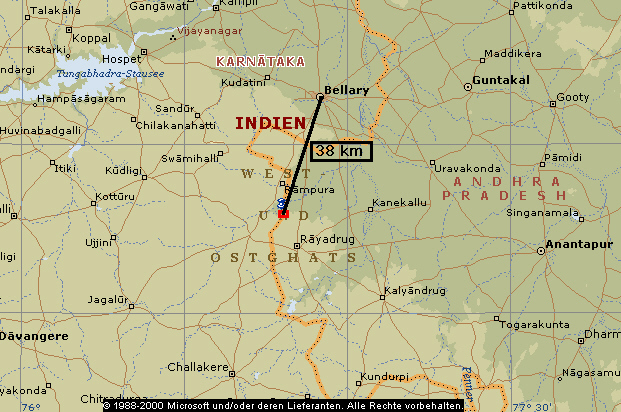
Abb.: Lage der Felsinschriften von Brahmagiri, Siddapura, Jaṭiṅga-Rāmeśvara
[©MS Encarta. Alle Rechte vorbehalten]
Hultzsch über diese und die beiden folgenden Inschriften in Karnataka:
"VI, VII, VIII. Rock-Inscriptions in the Mysore State (Text, p. 175). These three records, which resemble the Rūpnāth, Sahasrām, Bairāṭ, and Maski edicts, but add to them a second edict, were discovered and edited with lithographs by Mr. B. L. Rice in 1892. They were discussed by Senart, who added a transcript and translation of the Brahmagiri version (JA (8), 19. 472 ff.), and by Bühler, who corrected a few details (VOJ, 7. 29 ff.). In 1894 Bühler re-edited the three inscriptions with photo-lithographs prepared from inked estampages (EI, 3. 134 ff.). Transcripts and facsimiles are given also in Rice's Epigraphia Carnatica, vol. 11, from which I borrow the following careful description of the localities (Introduction, p. 2 f.):
'The Aśoka inscriptions discovered by me were three in number, situated on hills on the right and left banks of the Janagi-haḷḷa or Chinna Haggari river, where it crosses the Moḷkālmuru tāluq [of the Chitaldroog district of the Mysore State] from west to east. They are all in the neighbourhood of Siddāpura, between 14°47' and 51' north latitude and about 76°51' east longitude. The best preserved is the Brahmagiri inscription, engraved on the top of a great boulder of gneiss, at the north-west base of the hill of that name, at a point called the Ganjiguṇṭe-mūle. The boulder was well known throughout the neighbourhood as the Akshara-guṇḍu or "letter-rock ", and was supposed to be endued with medicinal virtues. Accordingly, in various ailments of human beings and in diseases of cattle, the stone was washed and the water used for the purpose given to the patient to drink. It was the favourite seat for goatherds in the heat of the day when the flocks were collected into the shade of the surrounding rocks, and for ryots watching the crops in the neighbouring fields. The inscription is cut on the undressed horizontal surface of the rock, which slopes down somewhat at the end of the lines. It consists of thirteen not very regular lines, covering a space of 15' 6" by 11' 6". Half a dozen letters at the beginning of the 6th and 7th lines have been defaced by lodgment of water in a depression in the stone.'
'The second inscription is less than a mile to the west of the first, and close to Siddāpura, on a ledge, facing south, some way up a rocky group of hills called Yenamana Timmayyana guṇḍlu or "the buffalo-herd Timmayya's rocks ". It consists of twenty-two lines, covering a space of 13' 6" by 8', and is engraved in lines of varying length on the sloping and peeling horizontal surface of the rock. A great boulder overhangs the inscription on the north, under the eaves of which the lines end, leaving a very small space between the inscribed floor and the rock above. Considerable portions have been defaced, as the shady ledge on which the inscription is cut formed a favourite shelter for goats and cattle.'
'The third inscription is on the western summit of the Jaṭiṅga-Rāmeśvara hill, which is some three miles or more north by west of Brahmagiri. The inscription is cut on a very irregular slanting horizontal surface of rock, facing north-east, which has been quarried at some period. Overhanging the inscription on the south is an immense boulder, which still shows the marks of the mason's punches used in splitting off a considerable portion of its northern face. The floor on which the inscription is cut is immediately in front of the stairs leading up to the Jaṭiṅga-Rāmeśvara temple. Consequently all pilgrims to the shrine used to walk right over the inscription, and have no doubt done so for centuries. Moreover, owing to the convenient shadow of the overhanging boulder, the site of the inscription was the favourite resort of the bangle-sellers at the annual festival. Hence the rock is called the Baḷegāra-guṇḍu or "bangle-sellers' rock", and various holes have been punched in different parts of the rock on which the inscription is cut to receive the posts of the booths or tents erected by them at the annual fair. For the foregoing reasons it is not surprising that the inscription is very greatly defaced, so much so indeed that it is difficult to tell exactly where it begins or where it ends. So far as can be made out, it consists of at least twenty-eight lines, covering a space of 17' 6" by 6' 6". There is a guiding line engraved in the margin to the left, apparently to show the direction of the lines, but those above this mark do not seem to have been parallel with those below it.'
From a foot-note we are glad to learn that 'erections have now been put up over this and the other Aśoka inscriptions by the Mysore Government for their protection, and the headman of the village has the keys as custodian'."
[Quelle: Inscriptions of Aśoka / new ed. By E. Hultzsch. With 55 plates. -- 1925. -- cxxxi, 260 S. : Ill. ; 35 cm. -- Supersedes: Inscriptions of Aśoka / Prepared by Alexander Cunningham. -- Calcutta, 1887. -- (Corpus inscriptionum indicarum ; vol. I). -- S. XXVIf.]
Übersetzung von Hultzsch:
(A) From Suvarṇagiri, at the word of
the prince (āryaputra) and of the Mahāmātras, the Mahāmātras at Isila must be
wished good health and be told this:
(B) Devānāṃpriya commands (as follows).
(C) More than two and a half years (have passed) since I (am) a lay-worshipper (upāsaka).
(D) But indeed I had not been very zealous for one year.
(E) But indeed a year and somewhat more (has passed) since I have visited the
Saṃgha and have been very zealous.
(F) But men in Jambudvīpa, being during that time unmingled, (are now) mingled
with the gods.
(G) For this is the fruit of zeal.
(H) For this cannot be reached by (a person) of high rank alone, but indeed even
a lowly (person) can at liberty attain the great heaven if he is zealous.
(I) For the following purpose has this proclamation been issued, [that both the
lowly] and those of high rank may be zealous in this manner, and (that even) my
borderers may know (it), and (that) this zeal may be of long duration.
(J) And this matter will (be made by me to) progress, and will (be made to)
progress even considerably; it will (be made to) progress to at least one and a
half.
(K) And this proclamation was issued by (me) on tour.
(L) 256 (nights had then been spent on tour).
(M) Moreover, Devānāṃpriya speaks
thus.
(N) Obedience must be rendered to mother and father, likewise to elders;
firmness (of compassion) must be shown towards animals; the truth must be
spoken: these same moral virtues must be practised.
(O) In the same way the pupil must show reverence to the master, and one must
behave in a suitable manner towards relatives.
(P) This is an ancient rule, and this conduces to long life.
(Q) Thus one must art.
(R) Written by Chapaḍa the writer.
Barābār Caves, Jehanabad District, Bihar (बिहार) -- 25°02' N 85°03' E
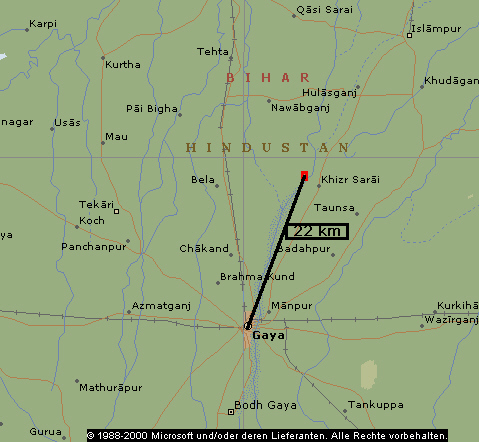
Abb.: Ungefähre Lage der Barābar-Höhlen
[©MS Encarta. Alle Rechte vorbehalten]
Hultzsch über diese Inschrift:
"IX. The Barābar Hill Cave-Inscriptions (Text, p. 181) 'The Hills called Barābar are isolated rocks of syenitic granite rising abruptly from the plain about 15 miles north of the city of Gayā' in South Bihār. 'Although Barābar is that by which the cluster is commonly known, each hill has a name of its own, the highest being called "Barābar", also "Siddheśvar" from a temple to Mahādeva that once crowned it.'
'All of these possess some Buddhistic remains, but the most interesting are the caves of Barābar and Nāgārjunī, which were hewn out of the solid rock upwards of two thousand years ago.'
'There are altogether seven caves in these hills, four of which belong to the Barābar or Siddheśvara group, and three to the Nāgārjunī group.' Each of the three Nāgārjunī caves contains an inscription of Dashalatha Devānāṃpiya, i.e. Aśoka's grandson Daśaratha. Among the four Barābar caves, three bear an inscription of king Devānāṃpiya, and one (the so-called ' Lomaśa Ṛishi cave') a Vaishṇava inscription of the Maukhari Anantavarman, which seems to show that the original name of the Barābar Hill was Pravaragiri.
According to the second and third Barābar inscriptions the name of the Barābar Hill was then Khalatika. Both the first and second inscriptions of king Devānāṃpiya and the three Nāgārjunī inscriptions of Daśaratha specify as donees the monks of the Ājīvika sect. In three cases an attempt has been made to chisel away the word Ājīvikehi. This was probably done in the time of the Maukhari Anantavarman, who assigned one of the Barābar caves to Kṛishṇa, and two of the Nāgārjunī ones to Śiva and Pārvatī.
The three Barābar inscriptions of king Devānāṃpriya were first lithographed and discussed by Captain Kittoe. They were examined by Burnouf (Lotus, p. 779 ff.) and edited by Senart and, with Fleet's facsimiles, by Bühler (IA, 20. 361 ff.)."
[Quelle: Inscriptions of Aśoka / new ed. By E. Hultzsch. With 55 plates. -- 1925. -- cxxxi, 260 S. : Ill. ; 35 cm. -- Supersedes: Inscriptions of Aśoka / Prepared by Alexander Cunningham. -- Calcutta, 1887. -- (Corpus inscriptionum indicarum ; vol. I). -- S. XXVII.]
Übersetzung von Hultzsch:
1. Inschrift:
By king Priyadarśin, (when he had been) anointed twelve years, this Banyan-cave was given to the Ājīvikas.
2. Inschrift:
By king Priyadarśin, (when he had been) anointed twelve years, this cave in the Khalatika mountain was given to the Ājīvikas.
3. Inschrift:
When king Priyadarśin had been anointed nineteen years, this cave in the very pleasant Kha[latika mountain] was given by me for (shelter during) the rainy season.
Bei Cehel Zina, Kandahar District (کندهار), Afghanistan -- 31°36' N 65°40' E
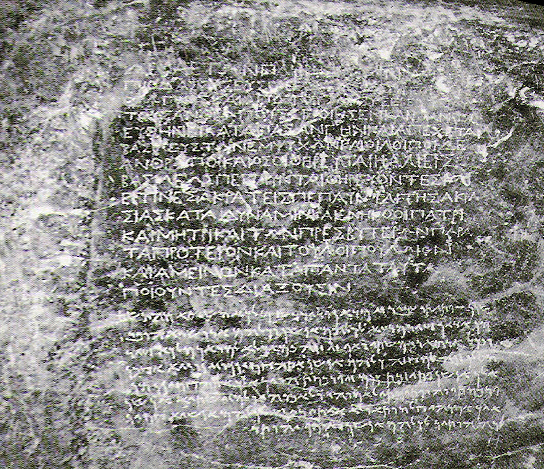
Abb.: Aśoka-Inschrift griechisch (oben) und aramäisch, Kandahar (کندهار),
Afghanistan
[Bildquelle: Wikipedia, Public domain]
[Quelle von Transliterationen und Übersetzung: http://en.wikipedia.org/wiki/Image:AśokaKandahar.jpg. -- Zugriff am 2008-02-28]
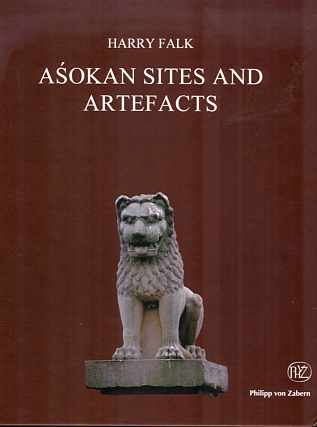
Abb.: Einbandtitel
Falk, Harry: Aśokan sites and artefacts : a source book with bibliography. -- Mainz : Zabern, 2006. -- 295 S. : Ill. ; 31 cm. -- (Monographien zur indischen Archäologie, Kunst und Philologie ; Bd. 18). -- ISBN 978-3-8053-3712-0. -- Unentbehrliches Hilfsmittel. -- Mit ausführlichem Literaturverzeichnis (S. 14 - 54).
Zu 2. 2. Die Asiatic Society in Calcutta. J. Prinsep und die Aśoka-Inschriften / von Ernst Windisch (1917)